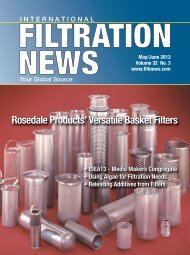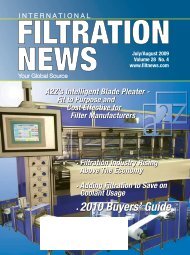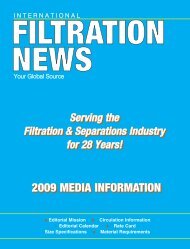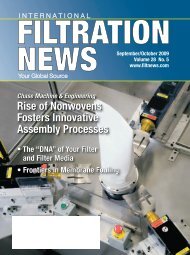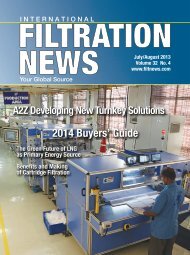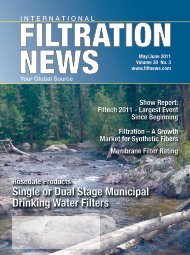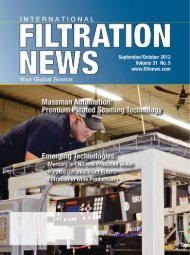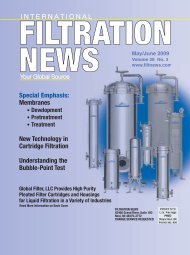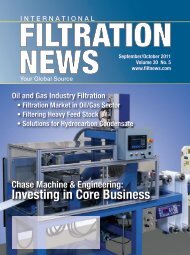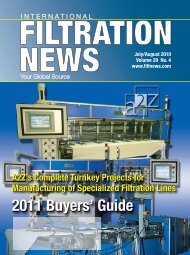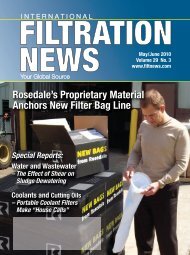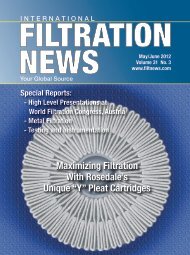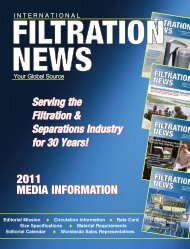The Value of Specialty Manufacturing Equipment in ... - Filtration News
The Value of Specialty Manufacturing Equipment in ... - Filtration News
The Value of Specialty Manufacturing Equipment in ... - Filtration News
Create successful ePaper yourself
Turn your PDF publications into a flip-book with our unique Google optimized e-Paper software.
I N T E R N A T I O N A LFILTRATIONNEWSSeptember/October 2010Volume 29 No. 5www.filtnews.comYour Global Source<strong>The</strong> <strong>Value</strong> <strong>of</strong> <strong>Specialty</strong> <strong>Manufactur<strong>in</strong>g</strong><strong>Equipment</strong> <strong>in</strong> a Competitive MarketA Special Report from Chase Mach<strong>in</strong>e & Eng<strong>in</strong>eer<strong>in</strong>gIn MemoriamWells Shoemaker 1922-2010A Special Tribute to an Industry LeaderIndustry <strong>News</strong>Ch<strong>in</strong>a’s <strong>Filtration</strong> andSeparation IndustryStrongly Grow<strong>in</strong>g<strong>Filtration</strong> | MediaPlasma Process<strong>in</strong>gChang<strong>in</strong>g <strong>Filtration</strong>
Editorial Advisory BoardEditorial Board ChairmanEdward C. Gregor, ChairmanE.C. Gregor & Assoc. LLCTel: 1 704 442 1940Fax: 1 704 442 1778ecg@egregor.comM&A, <strong>Filtration</strong> MediaHaluk Alper, PresidentMyCelx Technologies Corp.Tel: 770.534.3118Fax: 770.534.3117alper@mycelx.comOil Removal – Water and AirPeter S. Cartwright, PECartwright Consult<strong>in</strong>g Co.cartwrightconsul@cs.comMembranes, RO,UltrafiltrationWu Chen<strong>The</strong> Dow Chemical CompanyTel: 1 979 238 9943Fax: 1 979 238 0651Process <strong>Filtration</strong> (liquid/gas)<strong>Equipment</strong> and MediaPeter R. Johnston, PETel/Fax: 1 919 942 9092ddandp3@aol.comTest proceduresJim JosephJoseph Market<strong>in</strong>gTel/Fax: 1 757 565 1549josephmarket<strong>in</strong>g@verizon.netCoolant <strong>Filtration</strong>Gerard J. Lynch, PESigma Design Co., LLCTel: 1 973 912 7922Fax: 1 973 912 5244gjlynch@sigmadesign.net<strong>Filtration</strong> Mach<strong>in</strong>ery &Product DesignDr. Ernest MayerDuPont Co.Tel: 1 302 368 0021Fax: 1 302 368 1474ernest.mayer@usa.dupont.comGeneral Solid/Liquid Separations<strong>in</strong> All AreasRobert W. Mcilva<strong>in</strong>eTel: 1 847 272 0010Fax: 1 847 272 9673mcilva<strong>in</strong>e@mcilva<strong>in</strong>ecompany.comwww.mcilva<strong>in</strong>ecompany.comMkt. Research & Tech. AnalysisHenry Nowicki, Ph.D. MBATel: 1 724 457 6576Fax: 1 724 457 1214Henry@pacslabs.comwww.pacslabs.comAbsorbent Test<strong>in</strong>gand Tra<strong>in</strong><strong>in</strong>gBrandon Ost, CEO<strong>Filtration</strong> GroupHigh Purity Prod. Div.Tel: 1 630 723 2900bost@filtrationgroup.comAir Filters, Pharmaceuticaland Micro-ElectronicDr. Graham RidealWhitehouse Scientific Ltd.Tel: +44 1244 33 26 26Fax: +44 1244 33 50 98rideal@whitehousescientific.comFilter and Media ValidationAndy RosolGlobal <strong>Filtration</strong> Products Mgr.FLSmidth M<strong>in</strong>eralsandy.rosol@flsmidth.comTel: 1 800 826 6461/1 801 526 2005Precoat/Bodyfeed Filter AidsGregg Poppe<strong>The</strong> Dow Chemical CompanyTel: 1 952 897 4317Fax: 1 942 835 4996poppeg@dow.comIndustrial Water, Power,and Membrane TechnologyTony ShucoskyPall MicroelectronicsTel: 1 410 252-0800Fax: 1 410 252-6027tony_shucosky@pall.comCartridges, Filter Media,MembranesScott P. Yaeger<strong>Filtration</strong> and SeparationTechnology LLCTel/Fax: 219-324-3786Mobile: 805-377-5082spyaeger@msn.comMembranes, New Techn.Wells ShoemakerAdvisory BoardMember EmeritusDr. Bob BaumannAdvisory BoardMember Emerituswww.filtnews.com • October 2010 • 3
Industry | EventsWorld-Lead<strong>in</strong>g L<strong>in</strong>eup for<strong>Filtration</strong> Society Conference <strong>in</strong> U.K.By Ken Norberg, EditorPore size measurement <strong>of</strong> a filter us<strong>in</strong>g glass calibration microspheres.<strong>The</strong> <strong>Filtration</strong> Society’s 2010(U.K.) annual conference andexhibition has once aga<strong>in</strong> attractedan impressive array <strong>of</strong> speakerswho are world leaders <strong>in</strong> their fields. “FilterTest<strong>in</strong>g 5 – millimeter to nanometer”takes place October 13, 2010 <strong>in</strong> Chester,U.K., and will be preceded by a short4 • October 2010 • www.filtnews.comcourse and workshop on October 12 forthose new to filter test<strong>in</strong>g, or who wishto further develop their knowledge <strong>in</strong>this field.Conference organizer Dr. GrahamRideal <strong>of</strong> Whitehouse Scientific is particularlypleased with the enthusiasticresponse he has received from those <strong>in</strong>vitedto present. “<strong>The</strong> Filter Test<strong>in</strong>g series<strong>of</strong> conferences has been runn<strong>in</strong>gfor more than 10 years and cont<strong>in</strong>uesto grow,” he said. “Once aga<strong>in</strong> I am delightedthat we have been able to attracta great l<strong>in</strong>e up <strong>of</strong> speakers. What’smore, a number <strong>of</strong> those present<strong>in</strong>g thema<strong>in</strong> conference sessions are alsoteach<strong>in</strong>g the pre-conference shortcourse, provid<strong>in</strong>g attendees with aunique learn<strong>in</strong>g opportunity.”<strong>The</strong> ma<strong>in</strong> conference beg<strong>in</strong>s withtwo plenary presentations <strong>in</strong> whichMark Crooks <strong>of</strong> TSI, U.K., will present“A review <strong>of</strong> ISO standards <strong>in</strong> relationto the dry test<strong>in</strong>g <strong>of</strong> filter media – theenvironmental driv<strong>in</strong>g force,” andChristope Peucheot <strong>of</strong> IFTS, Francewill discuss “Validation <strong>of</strong> liquid filtertest methods and equipment.” Hav<strong>in</strong>gset the scene, the rest <strong>of</strong> the conferenceis largely focused on the latest testmethods and equipment. <strong>The</strong> rema<strong>in</strong>der<strong>of</strong> the morn<strong>in</strong>g will be devoted toadvances <strong>in</strong> pore size distributionanalysis (Danny Pattyn, Benelux Scien-
tific) and analysis <strong>of</strong> surface area andpore size <strong>in</strong> the nanometre range (MikeTucker, Quantachrome).After lunch there is a look at filtertest<strong>in</strong>g by nanoparticle track<strong>in</strong>g analysis(Bob Carr, Nanosight), real-timemeasurement <strong>of</strong> the available absorptioncapacity <strong>of</strong> activated carbon cloth(Andrea Smith, Chemviron Carbon),the use <strong>of</strong> microsphere standards to determ<strong>in</strong>efilter cut po<strong>in</strong>ts and pore sizedistributions (Graham Rideal, WhitehouseScientific), and essential improvementsfor a reliable fractionalefficiency test <strong>of</strong> filter media and filters(Sven Schutz, Palas).A trade exhibition runn<strong>in</strong>g alongsidethe conference will also feature a“technology burst” session <strong>in</strong> which exhibitorsare given the opportunity tomake 5-10 m<strong>in</strong>ute presentations abouttheir products or services – an efficientmeans <strong>of</strong> <strong>in</strong>troduc<strong>in</strong>g delegates to allthat is available at the trade show.In summ<strong>in</strong>g up the significance <strong>of</strong>the conference, Dr. Rideal noted, “Recentenvironmental issues have reallybrought a wider recognition <strong>of</strong> theimportance <strong>of</strong> filter technology,whether we’re talk<strong>in</strong>g about protect<strong>in</strong>gaircraft from volcanic ash or filter<strong>in</strong>gsand from deep sea oil wells.Much has also been spoken about thereal or potential effects <strong>of</strong> nanoparticleson the environment and the importance<strong>of</strong> filtration. Our focus onfilter test<strong>in</strong>g provides <strong>in</strong>sight <strong>in</strong>to theperformance <strong>of</strong> filter media and helpsguide people <strong>in</strong> correctly specify<strong>in</strong>gproducts that are appropriate for theirapplications.”ABOUT WHITEHOUSE SCIENTIFICWhitehouse Scientific is a lead<strong>in</strong>gproducer <strong>of</strong> glass microspheres for calibrationand is the highest-rank<strong>in</strong>g Europeancertification laboratory forprimary methods <strong>of</strong> particle size analysis.<strong>The</strong> company’s standards cover allparticle-siz<strong>in</strong>g techniques <strong>in</strong>clud<strong>in</strong>glaser diffraction, Coulter methods, opticalsiz<strong>in</strong>g, sieve calibration and imageanalysis. Most <strong>of</strong> these reference materialsare NIST-traceable. <strong>The</strong>y range <strong>in</strong>size from 0.1 micron to 5.0 millimetersand are available as s<strong>in</strong>gle sizes orbroad distribution standards. In addition,Whitehouse <strong>of</strong>fers a unique calibrationprocedure for NIST-traceablemeasurement <strong>of</strong> filter apertures between3 and 1000 microns, and alsoproduces general-purpose researchgrade microspheres.Whitehouse Scientific has been produc<strong>in</strong>gcalibration microspheres formore than 25 years. Founder and manag<strong>in</strong>gdirector Dr. Graham Rideal is apast chairman <strong>of</strong> <strong>The</strong> <strong>Filtration</strong> Society,and is now active as its Science Correspondent.He is also a member <strong>of</strong> theEditorial Advisory Board <strong>of</strong> International<strong>Filtration</strong>FN<strong>News</strong>.For more conference <strong>in</strong>formation visit:www.filtsoc.orgFor company <strong>in</strong>formation contact:Dr. Graham RidealTel: +44 (0) 1244 332626Fax: +44 (0) 1244 335098Email: <strong>in</strong>fo@whitehousescientific.comWebsite: www.whitehousescientific.comwww.filtnews.com • October 2010 • 5
In MemoriamWells Shoemaker1922 - 2010A Personal Tributefrom Ed Gregor6 • October 2010 • www.filtnews.comIcannot th<strong>in</strong>k <strong>of</strong> anyone, who is more highlyadmired or has done more for the Americanfiltration <strong>in</strong>dustry than Wells Shoemaker whopassed away July 25, 2010. When consider<strong>in</strong>gthe names <strong>of</strong> giants <strong>in</strong> filtration, Wells ranks withthe best <strong>of</strong> them, even though he never ran a filtrationmanufactur<strong>in</strong>g company or <strong>in</strong>vented anyfiltration media, filter or system. What separatedWells were his persona, exceptional <strong>in</strong>dustryleadership and organizational abilities, but whattruly set him apart was he made everyone whomet him feel important. You appreciated his easyway, the warmth <strong>of</strong> his personality, and his abilitywith a few words or a nod to conv<strong>in</strong>ce you tohelp him with whatever filtration endeavor hewas pursu<strong>in</strong>g at the time. I learned this first handwhen I met Wells for the first time. He and HarrySandsteadt walked <strong>in</strong>to my <strong>of</strong>fice at Gelman Sciences<strong>in</strong> 1983. With<strong>in</strong> 15 m<strong>in</strong>utes I found myselfagree<strong>in</strong>g to give a presentation at a filtration conferencebe<strong>in</strong>g held <strong>in</strong> three weeks, and much tomy surprise volunteered to be on a committee <strong>of</strong>the American Program Committee, the predecessorto the American <strong>Filtration</strong> & Separations Society.It didn’t seem to matter that I had apend<strong>in</strong>g trip to Europe and was reorganiz<strong>in</strong>g afalter<strong>in</strong>g bus<strong>in</strong>ess unit that occupied all my time.I’ve s<strong>in</strong>ce learned, when Wells had an idea, anyidea, somehow everyone wanted to be part <strong>of</strong> it,and I was no exception.After graduat<strong>in</strong>g from Cornell University with achemical eng<strong>in</strong>eer<strong>in</strong>g degree, Wells served <strong>in</strong> theU. S. Navy for 4 years. Follow<strong>in</strong>g World War II,Lieutenant Shoemaker’s career began with early employmentat American Enka and Johnson and Johnsonwhere he was first exposed to filtration. Hislifelong devotion and enthusiasm for filtration wascemented when he jo<strong>in</strong>ed Eaton-Dikeman (nowAhlstrom <strong>Filtration</strong>) <strong>in</strong> Mt. Holly Spr<strong>in</strong>gs, PA <strong>in</strong>
1965. From his position <strong>in</strong> technical sales and responsibilitiesto sell filtration media, his natural abilitiesblossomed and beg<strong>in</strong> what would be fourdecades <strong>of</strong> leadership, plann<strong>in</strong>g skills, passion anddedication <strong>in</strong> organiz<strong>in</strong>g countless filtration Conferencesand <strong>Filtration</strong> Days across the United States.In 1981 Wells left Eaton-Dikeman to form his ownconsult<strong>in</strong>g company, Filterex, Inc. Now on this own,Wells really went to town, promot<strong>in</strong>g <strong>in</strong>dustry educationwhile build<strong>in</strong>g a wide follow<strong>in</strong>g <strong>of</strong> active participants,<strong>in</strong>dividuals, companies and competitorsalike at a torrid pace throughout all <strong>of</strong> Filterdom, aterm he co<strong>in</strong>ed and liked to use. He organized numerousevents, Conferences and <strong>Filtration</strong> Days <strong>in</strong>Monterey, Williamsburg, Pr<strong>in</strong>ceton, Valley Forge,Hersey, Fl<strong>in</strong>t, Ocean City and many other locations,as many <strong>of</strong> us fondly recall. His Membrane Conferences<strong>in</strong> conjunction with the BCC began <strong>in</strong> 1982and, under his guidance for almost 20 years, was theforemost membrane conference <strong>of</strong> the <strong>in</strong>dustry.Wells always was ready to plow new ground. In 1991he ran a conference titled “<strong>The</strong> Pore” with FrankTiller and Ted Meltzer contribut<strong>in</strong>g. Consider hisimag<strong>in</strong>ation. Who would ever th<strong>in</strong>k to organize aConference to discuss the Pore…not the media, butonly the hole and get over 120 people to attend. Beg<strong>in</strong>n<strong>in</strong>g<strong>in</strong> the early 1960s through the mid-1980sWells organized many <strong>Filtration</strong> Society regionalchapters under the American Program Committeeon behalf <strong>of</strong> the <strong>Filtration</strong> Society <strong>in</strong> the U.K. Chaptersgrew like mushrooms as lead<strong>in</strong>g filter expertswere recruited or “co-opted” to manage new chaptersfrom New England, the Mid-Atlantic, Chicagoand Dixie and then on to California, with 11 activechapters – all this while manag<strong>in</strong>g his filtration mediaconsult<strong>in</strong>g bus<strong>in</strong>ess, which flourished <strong>in</strong> spite <strong>of</strong> allthe time he devoted to his passion <strong>of</strong> br<strong>in</strong>g<strong>in</strong>g the <strong>in</strong>dustrytogether. You always saw the light side <strong>of</strong>Wells at every conference, <strong>in</strong>clud<strong>in</strong>g his talk on thewww.filtnews.com • October 2010 • 7
“<strong>The</strong> <strong>Filtration</strong> Pill,” and what good it does for youif you swallow it. He organized and sang barbershopas part <strong>of</strong> the “Un-Filterable Four” at many a conference,and once Wells even arranged a local highschoolband to parade <strong>in</strong> with trumpets anddrummers fill<strong>in</strong>g the room with march music dur<strong>in</strong>ga network<strong>in</strong>g reception. Someth<strong>in</strong>g new and unexpectedalways provided a last<strong>in</strong>g memory.For his skills, the <strong>Filtration</strong> Society <strong>in</strong> the U.K.elected Wells as the first <strong>of</strong> only two [ever] International<strong>Filtration</strong> Society Chairmen. Follow<strong>in</strong>ghis exemplary leadership as Chairman, the <strong>Filtration</strong>Society awarded him the first World <strong>Filtration</strong>Congress to the United States, held <strong>in</strong>Down<strong>in</strong>gtown, PA <strong>in</strong> 1982. Aga<strong>in</strong>, Wells steppedforward to organize the event, which still rema<strong>in</strong>sthe standard by which all World Congresses arejudged. However, <strong>in</strong> the mid-1980s relations betweenthe <strong>Filtration</strong> Society and the AmericanProgram Committee began to deteriorate to thepo<strong>in</strong>t <strong>of</strong> ultimately culm<strong>in</strong>at<strong>in</strong>g <strong>in</strong> the found<strong>in</strong>g<strong>of</strong> the American <strong>Filtration</strong> & Separations Society(AFS) <strong>in</strong> 1987 as a separate stand-alone Society. Iclearly recall the day wefounded the Society andI suggested we considercreat<strong>in</strong>g CorporateSponsorships. Immediately,Wells took out hispen and wrote someth<strong>in</strong>gon his bus<strong>in</strong>esscard and handed it tome, which I still keeptoday. It read: “OneCorporate Membership.I.O.U. $1,000.” Len Ort<strong>in</strong>owas sitt<strong>in</strong>g to myleft and said, “Count me<strong>in</strong> as well.” Before the
day was out, I had corporate promises <strong>of</strong> $5,000!Wells never sought credit or held any <strong>of</strong>fice <strong>in</strong> theAFS, but was always there as a contributor, evenat the age <strong>of</strong> 85. Wells and Don Olds teamed up <strong>in</strong>November 2007 to run a Conference <strong>in</strong> Knoxville,where he drew the who’s who <strong>of</strong> the <strong>in</strong>dustry asspeakers. Wells still had that same old magic andreceived a stellar Conference review and as usualand most importantly, his lovely wife <strong>of</strong> 66 years,Sara, was at his side as she has been for over theyears at virtually every <strong>in</strong>dustry event. Even <strong>in</strong>retirement, Wells organized. It was just part <strong>of</strong> hisDNA. As Scott Yaeger said recently, “Wells undoubtedlyis organiz<strong>in</strong>g the Heaven <strong>Filtration</strong> Societyat this time.” When he and Sara moved toSparta, NC from Fairfield, PA <strong>in</strong> early 2007, at theage <strong>of</strong> 85 and shortly after heart surgery, Wellsfounded the Sparta Newcomers Club, and helpedwrite and participated <strong>in</strong> several plays as part <strong>of</strong>the local community theater group. His organizationalskills were honed with many years work<strong>in</strong>gwith local church groups, and the Rotary Clubwherever he and Sara lived over the years.Wells Shoemaker is the Father <strong>of</strong> the American<strong>Filtration</strong> and Separations Society. He fostered more<strong>in</strong>terest <strong>in</strong> filtration and separations at any level thanany <strong>in</strong>dividual I know. Today, filtration and separationsis a true growth <strong>in</strong>dustry with annual growthat 4-6 percent per year above GDP, whether theeconomy is up, down or sideways. <strong>The</strong> steady hand<strong>of</strong> Wells Shoemaker has surely played a role <strong>in</strong> help<strong>in</strong>gto achieve this success. Wells was an idea manarmed with charm, wit and an <strong>in</strong>nate ability to br<strong>in</strong>gpeople together for a common cause and have funwhile do<strong>in</strong>g it––everyth<strong>in</strong>g about him was quality.Wells left all <strong>of</strong> us with a great <strong>in</strong>dustrylegacy and he will forever be remembered <strong>in</strong> theannals <strong>of</strong> Filterdom. We all salute him and extendour sympathies to his wife Sara and all theShoemaker Family.FN
<strong>Filtration</strong> | MediaPlasma Process<strong>in</strong>g Chang<strong>in</strong>g <strong>Filtration</strong>By Stephen Coulson, Ph.D., Chief Technical Officer, P2iPlasma process<strong>in</strong>g <strong>of</strong> filtration media can <strong>in</strong>crease oil and water repellency while ma<strong>in</strong>ta<strong>in</strong><strong>in</strong>g pore size distribution and airflow.Membrane and nonwovenfilters are widely used bythe <strong>in</strong>dustry to separatesolids from liquids or gases. Filterscan range from the conventional,such as simple dust filters for air <strong>in</strong>takes,to the critical,such asdialysis filters toprevent kidneyfailure. In fact,there are morethan 50 filters <strong>in</strong> as<strong>in</strong>gle car. <strong>The</strong>worldwide filter<strong>in</strong>dustry is expectedto expand5.6% through2010 to a value <strong>of</strong>$45 billion.<strong>Filtration</strong>media is generallyselected based onreasons <strong>of</strong> cost,ease <strong>of</strong> process<strong>in</strong>gand performancerequirements.Many differentmaterials can beused, but wherefilters are <strong>in</strong>tendedfor repeateduse, it isvitally importantthat <strong>in</strong>tegrity and10 • October 2010 • www.filtnews.comconsistency <strong>of</strong> pore size is reta<strong>in</strong>edthroughout a product’s lifetime despitethe <strong>of</strong>ten harsh environmentsthey are exposed to, <strong>in</strong>clud<strong>in</strong>g clean<strong>in</strong>gprocesses.In order to achieve this level <strong>of</strong> reliability,reusable filtration mediahave traditionally been made fromhighly resistant and rigid polymers,such as polyv<strong>in</strong>ylidene fluoride(PVDF) and polytetrafluoroethylene(PTFE). However, these materialstend to be fairly costly and wouldstill benefit from complex chemicalf<strong>in</strong>ishes to add further performancebenefits. A more desirable scenario,therefore, would be to use cheaper,easily formed filter media and thenmodify the surface us<strong>in</strong>g an additionalprocess to impart the desiredliquid resistance.Thanks to the pioneer<strong>in</strong>g work <strong>of</strong>P2i and its revolutionary liquid repellentnano-coat<strong>in</strong>g, it is now possibleto enhance alternative, moresusta<strong>in</strong>able filtration media – such ascellulose or nylon – to a level thatmatches, or exceeds, the performance<strong>of</strong> traditional, more expensivematerials that are more difficult towork with. Indeed, us<strong>in</strong>g the widelyaccepted American Association <strong>of</strong>
<strong>Filtration</strong> | MediaP2i’s technology can enhance the performance <strong>of</strong> a wide range <strong>of</strong> filter media andcomplete filtration systems.Textile Chemists and Colorists conventions,P2i’s nano-coat<strong>in</strong>g has beenshown to create filters with the maximumlevels <strong>of</strong> liquid repellency <strong>in</strong>both the AATCC 193-2007 water repellencytest (resist<strong>in</strong>g 100% isopropylalcohol) and the AATCC118-2007 oil repellency test (resist<strong>in</strong>gn-heptane).Us<strong>in</strong>g a special pulsed ionized gas(plasma), which is created with<strong>in</strong> avacuum chamber, the patented P2itechnology attaches a nanometerth<strong>in</strong>polymer layer over the entiresurface <strong>of</strong> a product. This dramaticallylowers the product’s surface energy,so that when liquids come <strong>in</strong>tocontact with it, they form beads andsimply run <strong>of</strong>f.In filtration media, the P2i nanocoat<strong>in</strong>g<strong>in</strong>creases oil and water repellencywithout affect<strong>in</strong>g the material’sbulk properties or pore size distribu-12 • October 2010 • www.filtnews.com
<strong>Filtration</strong> | Mediation and, therefore, airflow. It hasalso been shown to exhibit improvedcake release, no pressure drop or decrease<strong>in</strong> water entry pressure and alower replacement frequency, mean<strong>in</strong>gless waste. This allows productsto perform at a much higher level <strong>in</strong>a wide range <strong>of</strong> application sectors,<strong>in</strong>clud<strong>in</strong>g biosciences, <strong>in</strong>dustrial process<strong>in</strong>g,laboratory test<strong>in</strong>g, food &beverage, electronics and water treatment,as well as open<strong>in</strong>g up new applicationsaltogether.A PROBLEM SOLVEDP2i’s technology is genu<strong>in</strong>ely revolutionaryfor filtration because itsolves so many <strong>of</strong> the <strong>in</strong>dustry’s traditionalchallenges. For example, untilnow the choice <strong>of</strong> filter material hasusually been dictated pr<strong>in</strong>cipally bydesirable bulk physical properties andease <strong>of</strong> process<strong>in</strong>g. In many cases,however, this has led to a compromise<strong>in</strong> material surface properties, whichmay not be ideal for the <strong>in</strong>tended use,requir<strong>in</strong>g treatment with complexchemical formulations and high cur<strong>in</strong>gtemperatures. In turn that has ledto manufactur<strong>in</strong>g processes that arepower hungry, time consum<strong>in</strong>g, andlimited to specific materials that willwithstand the chemicals and high cur<strong>in</strong>gtemperatures <strong>in</strong>volved. <strong>The</strong>seprocesses are expensive and can havesignificant environmental impacts.P2i’s technology, by contrast, islow-energy, solvent-free and usesonly t<strong>in</strong>y quantities <strong>of</strong> protectivemonomer, result<strong>in</strong>g <strong>in</strong> m<strong>in</strong>imal wasteand no adverse impact on the environment.Plus, because the nanocoat<strong>in</strong>gis applied with<strong>in</strong> a vacuumchamber, there is no release to theenvironment dur<strong>in</strong>g process<strong>in</strong>g and,s<strong>in</strong>ce the nano-coat<strong>in</strong>g is molecularlybonded to the product, there is nowash <strong>of</strong>f, leachables or extractables.COMPONENTS TO ASSEMBLIESIn addition to enhanc<strong>in</strong>g filtrationmedia, P2i’s technology is alsoequally effective at treat<strong>in</strong>g the <strong>of</strong>tencomplex structures they are formed<strong>in</strong>to. For example, filter media aregenerally manufactured <strong>in</strong> 2D formthough rarely used <strong>in</strong> this format.<strong>The</strong> sections required are cut <strong>in</strong>to thedesired shapes and configured <strong>in</strong>to elementsconta<strong>in</strong>ed <strong>in</strong> hous<strong>in</strong>gs. <strong>The</strong>secan be used to form a larger system <strong>in</strong>order for the filter element or systemto perform the desired function.Because P2i’s protective polymer isformed <strong>in</strong> a gas plasma, it permeatesevery exposed surface <strong>of</strong> f<strong>in</strong>ished filterstructures, mean<strong>in</strong>g that the membranemay be treated while sealed <strong>in</strong>a permanent hous<strong>in</strong>g. It also meansthat the same chemistry can be impartedto a wider range <strong>of</strong> media, <strong>in</strong>clud<strong>in</strong>gsurface and depth filtermedia, woven and nonwoven textiles,14 • October 2010 • www.filtnews.com
membranes and media comb<strong>in</strong>ationscreated to form a filter medium, elementor system format. Other associatedbenefits are <strong>in</strong>creased liquidprotection and greater work<strong>in</strong>g efficiencies<strong>in</strong> harsh environments,which <strong>in</strong> turn translates <strong>in</strong>to benefitssuch as longer filtration life, higherperformance (<strong>in</strong> terms <strong>of</strong> reducedpressure drop and higher particle captureefficiency), and pleatability.COST-EFFECTIVEIncreas<strong>in</strong>g environmental concerns,demands for product cleanl<strong>in</strong>essand the grow<strong>in</strong>g need forcontam<strong>in</strong>ant reduction <strong>in</strong> sectorssuch as electronics, and medical andbiological <strong>in</strong>dustries means the marketfor filters is grow<strong>in</strong>g rapidly.P2i’s liquid repellent nano-coat<strong>in</strong>gtechnology allows reusable filtrationproducts to perform at a much higherlevel <strong>in</strong> their <strong>in</strong>tended applicationthrough <strong>in</strong>creased oil and water repellencywithout affect<strong>in</strong>g airflow,porosity or other crucial <strong>in</strong>dicators,such as cake release. Furthermore,this multi-patented <strong>in</strong>novation iscost-effective and environmentallyfriendly for enhanc<strong>in</strong>g cheaper filtermediums, such as cellulose or nylon,without compromis<strong>in</strong>g performance.Both the wide variety <strong>of</strong> filtermedia and the complex structures <strong>in</strong>volvedmake the P2i enhancementprocess highly sought after. <strong>The</strong> companyis already work<strong>in</strong>g with some <strong>of</strong>the world’s lead<strong>in</strong>g filtration manufacturersand has been provid<strong>in</strong>gprocessed media <strong>in</strong>to the marketFNplace for more than six years.About the AuthorStephen Coulson, Ph.D., is the Chief TechnicalOfficer <strong>of</strong> P2i. Mr. Coulson <strong>in</strong>vented theP2i technology while carry<strong>in</strong>g out his Ph.D.at Durham University on ‘Liquid repellentsurfaces’. He was consequently employedby the MoD to set up a plasma capabilityand further scale-up the patented technologyfor <strong>in</strong>dustrial applications. In 2001, Mr.Coulson moved <strong>in</strong>to project manag<strong>in</strong>g theUK Nuclear Biological and Chemical cloth<strong>in</strong>gprogram, but cont<strong>in</strong>ued to exploit theplasma technology for a range <strong>of</strong> commercialapplications. Mr. Coulson was thefound<strong>in</strong>g member <strong>of</strong> P2i when it was formed<strong>in</strong> January 2004 and has more than adecade’s experience <strong>in</strong> advanced materialsciences and plasma process<strong>in</strong>g.Visit us onl<strong>in</strong>e: www.filtnews.comBack Your Filters BetterExtensive Range <strong>of</strong> Expanded Metals & Polymers Perfect for membrane support & back<strong>in</strong>g Assures media <strong>in</strong>tegrity & pleatspac<strong>in</strong>g even under dynamic flow Materials lam<strong>in</strong>ate for co-expansion/contraction/flex Open<strong>in</strong>gs down to25 micron Thickness: 0.001”to 0.2”Dexmet Eng<strong>in</strong>eerswelcome the challenge<strong>of</strong> your unique materialsand applicationsCustom-ExpandedMaterials from203 294 4440 www.dexmetfilter.comwww.filtnews.com • October 2010 • 15
Cover Story | Chase Mach<strong>in</strong>e & Eng<strong>in</strong>eer<strong>in</strong>g<strong>The</strong> <strong>Value</strong> <strong>of</strong> <strong>Specialty</strong> <strong>Manufactur<strong>in</strong>g</strong><strong>Equipment</strong> <strong>in</strong> a Competitive MarketHVAC Pocket Filter L<strong>in</strong>e improves quality and reduces defects with ultrasonic bond<strong>in</strong>g.Modular design allows customers immediate market entrance at a reduced cost.Every equipment supplier hasspecial capabilities and ChaseMach<strong>in</strong>e & Eng<strong>in</strong>eer<strong>in</strong>g Inc. isno exception. <strong>Equipment</strong> is traditionally<strong>of</strong> a commodity nature or speciallydesigned to accommodate particularmanufactur<strong>in</strong>g needs. <strong>Specialty</strong> equipmentsuppliers such as Chase Mach<strong>in</strong>eare <strong>of</strong>ten asked to suggest better conceptsto enable lower process<strong>in</strong>g costsor the manufacture <strong>of</strong> products withunique capabilities. Experience andknowledge <strong>of</strong> the <strong>in</strong>dustry and customermanufactur<strong>in</strong>g processes are importantaspects <strong>in</strong> br<strong>in</strong>g<strong>in</strong>g suchconcepts to reality.DIFFERENTIATION IS THE KEYWithout question, product differentiationis the most important <strong>of</strong>fer<strong>in</strong>g acompany can provide to its customers.Chase Mach<strong>in</strong>e differentiates itself <strong>in</strong> anumber <strong>of</strong> ways beyond simply <strong>of</strong>fer<strong>in</strong>gcompetitive pric<strong>in</strong>g. <strong>The</strong>y <strong>in</strong>clude:•All products are made <strong>in</strong> ChaseMach<strong>in</strong>e’s manufactur<strong>in</strong>g plant <strong>in</strong> theUnited States.•In-house eng<strong>in</strong>eer<strong>in</strong>g capabilitiesemploy<strong>in</strong>g state-<strong>of</strong>-the-art 3-D solidmodel<strong>in</strong>g s<strong>of</strong>tware, comb<strong>in</strong>ed withweb handl<strong>in</strong>g and pick and placeautomation expertise, sets thecompany apart <strong>in</strong> most cases.•<strong>Filtration</strong> product design concepts,which allow customers to successfully sell aga<strong>in</strong>st competition – that’swhat 56 years <strong>of</strong> bus<strong>in</strong>ess experienceand talented employees can provide.•Custom eng<strong>in</strong>eered equipment andmanufactur<strong>in</strong>g processes that permitcustomers to ga<strong>in</strong> market sharethrough manufactur<strong>in</strong>g efficiencyand low-cost production.•Vertical <strong>in</strong>tegration, <strong>in</strong>clud<strong>in</strong>gelectrical panel build<strong>in</strong>g and PLCprogramm<strong>in</strong>g, mach<strong>in</strong><strong>in</strong>g, weld<strong>in</strong>gfabrication, pa<strong>in</strong>t<strong>in</strong>g and f<strong>in</strong>almach<strong>in</strong>e assembly ensures fullcontrol from both a quality anddelivery standpo<strong>in</strong>t.•Process filtration equipment maderight the first time.•Reliable and superior processes onthe shop floor – as only an operationmanager and the CFO can truly16 • October 2010 • www.filtnews.comappreciate, sometimes “good enough”is not good enough.EQUIPMENT NEEDS HAVE SHIFTED<strong>The</strong> shift from conventional glassand cellulose filtration media to syntheticnonwoven meltblown, spunbondand needlepunch fabrics hasopened the door for the <strong>in</strong>troduction<strong>of</strong> new and excit<strong>in</strong>g assembly methods.Technologies such as ultrasonics,hot air, band seal<strong>in</strong>g, RF andimpulse weld<strong>in</strong>g are becom<strong>in</strong>g commonpractices with<strong>in</strong> the <strong>in</strong>dustry.Eng<strong>in</strong>eers now select media not onlybased on filtration performance criteria,but also on assembly preference.Needle and threads comb<strong>in</strong>edwith adhesives are slowly be<strong>in</strong>gphased out – why <strong>in</strong>corporate anothercomponent (and expense) <strong>in</strong>tothe f<strong>in</strong>al product, especially whenthere are safer and more environmentallyfriendly alternatives?
Liquid Filter Bag Mach<strong>in</strong>e produces awide range <strong>of</strong> products for vary<strong>in</strong>g filtrationneeds, <strong>in</strong>clud<strong>in</strong>g needle punchand spunbound/meltblown filter media.S<strong>in</strong>gle Position Ultrasonic R<strong>in</strong>g Welderallows maximum operator efficiency withergonomic eng<strong>in</strong>eer<strong>in</strong>g practices, and isdesigned to be safe and operator-friendly.SYNTHETIC NONWOVENS - GROWTHChase Mach<strong>in</strong>e & Eng<strong>in</strong>eer<strong>in</strong>g hasembraced the move from conventionalfiltration media to synthetic nonwovens.Heat seal<strong>in</strong>g technologies, when<strong>in</strong>corporated <strong>in</strong>to a cont<strong>in</strong>uous process,can reduce labor and ma<strong>in</strong>tenance expensess<strong>in</strong>ce consumables such as adhesivesor sew<strong>in</strong>g supplies are nolonger required. While it is understoodthat some filter requirements call forthe use <strong>of</strong> cellulose and glass fibers thatrequire adhesives and/or sew<strong>in</strong>g, applicationsthat lend themselves to the use<strong>of</strong> synthetic media have generated excit<strong>in</strong>gnew assembly alternatives.<strong>The</strong> liquid filter bag market presentsan excellent example <strong>of</strong> multiple technologiescomb<strong>in</strong><strong>in</strong>g with<strong>in</strong> the sameprocess to improve manufactur<strong>in</strong>g performance.Employ<strong>in</strong>g hot air weld<strong>in</strong>g,Chase Mach<strong>in</strong>e jo<strong>in</strong>ed the two edges <strong>of</strong>a needlepunch fabric to create a tube ona cont<strong>in</strong>uous basis. At the same time,the company <strong>in</strong>tegrated Ultrasonics tocut and seal the bottom <strong>of</strong> the filter,free<strong>in</strong>g the end product <strong>of</strong> loose fibersand contam<strong>in</strong>ants. <strong>The</strong> process gavethe end user complete control whilecutt<strong>in</strong>g labor expenses by more than50% and elim<strong>in</strong>at<strong>in</strong>g the need for ancillaryconsumables. What’s more, thef<strong>in</strong>ished bag could be jo<strong>in</strong>ed to a plasticr<strong>in</strong>g us<strong>in</strong>g ultrasonic plunge weldersand elim<strong>in</strong>at<strong>in</strong>g the conventionalsew<strong>in</strong>g method for attachment.Ultrasonics is also commonly used<strong>in</strong> the synthetic HVAC filtration market.Chase Mach<strong>in</strong>e was <strong>in</strong>strumental<strong>in</strong> this transition with the development<strong>of</strong> the extended HVAC pocket filter mach<strong>in</strong>e,which was designed, built andpatented <strong>in</strong>corporat<strong>in</strong>g ultrasonic technology<strong>in</strong>to the cont<strong>in</strong>uous assemblyprocess. Nonwovens manufacturers realizedthe importance <strong>of</strong> design<strong>in</strong>gmedia for use with Ultrasonics. In theearly years <strong>of</strong> development, consistencyand uniformity across wide meltblownand spunbond l<strong>in</strong>es was a challenge.<strong>The</strong> f<strong>in</strong>ished product, while suitable forthe filtration application, varied <strong>in</strong> itsdistribution <strong>of</strong> fiber. Although thisnever became an issue when sew<strong>in</strong>g,ultrasonic weld<strong>in</strong>g required greateruniformity and consistency.In the membrane market, nonwovensare chosen for their strength as a supportsubstrate. <strong>The</strong> synthetic component <strong>of</strong>the nonwovens affords the end user theability to splice membranes together oreven attach multiple layers to improvefiltration characteristics. Ultrasonics, impulseweld<strong>in</strong>g, or even simple bar seal<strong>in</strong>gtechnologies may be <strong>in</strong>corporated<strong>in</strong>to a process l<strong>in</strong>e. Chase Mach<strong>in</strong>e’s experiencewith membrane cast<strong>in</strong>g andhollow fiber process l<strong>in</strong>es helps customersdecide which technology suitstheir specific application best. <strong>The</strong>n theysubstantiate their conclusions <strong>in</strong> theChase Materials Applications Lab.CUSTOMER TESTING LABIn response to this need, Chase Mach<strong>in</strong>eestablished a Materials ApplicationsLab, which enables companies totest materials and assembly methods beforecommitt<strong>in</strong>g to full production.Work<strong>in</strong>g with some <strong>of</strong> the largest filtrationmedia manufacturers <strong>in</strong> the world,Chase Mach<strong>in</strong>e has run thousands <strong>of</strong>www.filtnews.com • October 2010 • 17Chase Mach<strong>in</strong>e’s Materials ApplicationLab allows customers to test materialsand assembly methods.feet <strong>of</strong> media to verify process improvements.Many <strong>of</strong> these improvementshave gone on to benefit the marketplace.MEMBRANE AND HOLLOW FIBERSChase Mach<strong>in</strong>e is an important supplier<strong>in</strong> the rapidly grow<strong>in</strong>g area <strong>of</strong> hollowfibers and flat sheet membranes,build<strong>in</strong>g equipment rang<strong>in</strong>g from s<strong>in</strong>glefiber lab scale pilot l<strong>in</strong>es, to large-scaleproduction systems. Hollow fibers andflat sheet membranes are highly efficient,<strong>of</strong>fer<strong>in</strong>g greater flow rates, andlower differential pressure and energyrequirements. Chase works hand <strong>in</strong>hand with customers to understand thestrict design and manufactur<strong>in</strong>g specificationsrequired to make their particularmach<strong>in</strong>ery. Like its nonwoven filtermanufactur<strong>in</strong>g equipment, Chase Mach<strong>in</strong>e’shollow fiber and flat sheet membraneprocess capabilities rely uponmany years <strong>of</strong> build<strong>in</strong>g equipment andprocesses confidential to each customer.CONCLUSIONToday’s filtration <strong>in</strong>dustry is constantlyevolv<strong>in</strong>g. Ongo<strong>in</strong>g improvements tochemistry and manufactur<strong>in</strong>g processes<strong>of</strong>fer <strong>in</strong>f<strong>in</strong>ite possibilities for new productdevelopment. With companies such asChase Mach<strong>in</strong>e <strong>of</strong>fer<strong>in</strong>g test<strong>in</strong>g, prototyp<strong>in</strong>gand full-scale process solutions, thetransition from concept to f<strong>in</strong>al product isFNnow faster than ever before.For more <strong>in</strong>formation contact:Chase Mach<strong>in</strong>e & Eng<strong>in</strong>eer<strong>in</strong>g, Inc.324 Wash<strong>in</strong>gton StreetWest Warwick, RI 02893Tel: 401-821-8879 Fax: 401-823-5543Website: www.chasemach<strong>in</strong>e.comMADE IN USA
Industry | <strong>News</strong>Ch<strong>in</strong>a’s <strong>Filtration</strong> and Separation Industryto Grow as Country Cleans up EnvironmentBy Jason Chen, Ch<strong>in</strong>a CorrespondentCh<strong>in</strong>a faces serious environmentalproblems due to thefast grow<strong>in</strong>g economy. It isthe largest carbon dioxide (CO 2 ) emitter<strong>in</strong> the world and its emissions <strong>of</strong>sulfur dioxide (SO 2 ) and chemical oxygendemand (COD) reached, respectively,23 million and 30 million metrictons <strong>in</strong> 2007.To reduce pollution and protectthe environment, Ch<strong>in</strong>a has set targetsto reduce 10% <strong>of</strong> its SO 2 emissionsand COD emissions by 2010from 2005, and reduce CO 2 <strong>in</strong>tensityby 40% to 45% from 2005 to 2020. Atthe same time, the Ch<strong>in</strong>ese economywill keep on grow<strong>in</strong>g over the nextdecade. As a result, the Ch<strong>in</strong>ese filtrationand separation <strong>in</strong>dustry is enter<strong>in</strong>ga sizeable growth-period.FILTRATION AND SEPARATION INDUSTRYAccord<strong>in</strong>g to Pr<strong>of</strong>essor WangYanxi and Dr. Yao Gongbi <strong>of</strong> CFS(Ch<strong>in</strong>ese <strong>Filtration</strong> Society), Ch<strong>in</strong>a’sfiltration and separation <strong>in</strong>dustry hasa total market scale <strong>of</strong> more than 150billion Yuan ($22 billion): more than60 billion Yuan for air pollution control,more than 50 billion Yuan forwater purification and waste waterdisposal, and approximately 25 billionYuan for solid-liquid separation<strong>of</strong> <strong>in</strong>dustrial production.Ch<strong>in</strong>a’s filtration and separation <strong>in</strong>dustrycan satisfy more than 90% <strong>of</strong> thedemand from the domestic market. <strong>The</strong>rema<strong>in</strong><strong>in</strong>g 10% are ma<strong>in</strong>ly importedfrom the United States, West Europeand Japan.<strong>The</strong>re are more than 2,000 companies<strong>in</strong> the Ch<strong>in</strong>ese filtration and separation<strong>in</strong>dustry. Most <strong>of</strong> thecompanies are based <strong>in</strong> the YangtzeDelta Area (Shanghai, JiangsuProv<strong>in</strong>ce, Zhejiang Prov<strong>in</strong>ce andAnhui Prov<strong>in</strong>ce), Pearl River Delta(Guangdong Prov<strong>in</strong>ce), and BohaiGulf Area (Beij<strong>in</strong>g, Tianj<strong>in</strong>, Liaon<strong>in</strong>gProv<strong>in</strong>ce and Hebei Prov<strong>in</strong>ce).18 • October 2010 • www.filtnews.com
Market details for the Ch<strong>in</strong>ese filtrationand separation <strong>in</strong>dustry:1. <strong>Filtration</strong> mach<strong>in</strong>ery market.This market amounts to 20 billionYuan. Ch<strong>in</strong>ese companies’ ma<strong>in</strong>products <strong>in</strong>clude –Pressure filter: Ch<strong>in</strong>esemanufacturers can produce plateand frame filter, recessed platefilter, pressure leaf filter, automaticpressure filter, and candle filter.Currently they don’t produce rotarypressure filter (BHS); Vacuumfilter: Ch<strong>in</strong>ese manufacturers canproduce horizontal belt filter,tilt<strong>in</strong>g pan filter, table filter, drumfilter, and disc filter; Ch<strong>in</strong>esecompanies also produce beltpressure filter for m<strong>in</strong><strong>in</strong>g selectionand silt dewater<strong>in</strong>g.2. Separation mach<strong>in</strong>ery market.This market amounts to 19 billionYuan. Ch<strong>in</strong>ese companies’ ma<strong>in</strong>products <strong>in</strong>clude –Solid-gas separation mach<strong>in</strong>es suchas cyclone separator; Solid-liquidseparation: Ch<strong>in</strong>ese manufacturerscan produce horizontal pushercentrifuge, siphonicscraper-unloaded centrifuge,vertical axis basket centrifuge withautomatic discharge, horizontalscroll discharge decantercentrifuge, top-suspensory-basketcentrifuge, tubular centrifuge, discseparator, centrifugal extractor, andhydrocyclone.3. Bag filtration.This market amounts to 14 billionYuan – more them 4 billion Yuan forfilter media. <strong>The</strong> growth rate <strong>of</strong>high-temperature resistant bag filterwill exceed 20% each year. Ch<strong>in</strong>acan produce s<strong>in</strong>tered metal net,metal fiber felt and ceramic filtermedia (tube, plate or other forms).Currently there are more than 100nonwoven producers engag<strong>in</strong>g <strong>in</strong> theproduction <strong>of</strong> filter media <strong>in</strong> Ch<strong>in</strong>a.4. Membrane filtration products.This market amounts to more than10 billion Yuan. Currently Ch<strong>in</strong>a stillneeds to import a lot <strong>of</strong> membranefrom the United States and othercountries.5. Filters & cartridges.This market amounts to morethan 10 billion Yuan. Ch<strong>in</strong>a is thelargest filters & cartridgesmanufactur<strong>in</strong>g center <strong>in</strong> the world.6. Filter media. This marketamounts to more than 10 billionYuan. <strong>The</strong> process<strong>in</strong>g measures<strong>in</strong>clude: woven, nonwoven,wet-laid (paper-mak<strong>in</strong>g), metals<strong>in</strong>ter<strong>in</strong>g, and composite(lam<strong>in</strong>ation, coat<strong>in</strong>g, andimpregnation).Visit us onl<strong>in</strong>e:www.filtnews.comFNwww.filtnews.com • October 2010 • 19
<strong>Filtration</strong>Mergers, Acquisitionsand DivesturesGL Capital, LLCPreview | FILTECH 2011FILTECH 2011 Expect<strong>in</strong>g anIncrease <strong>in</strong> Exhibitors and VisitorsWe understand the nuances <strong>of</strong>the domestic and <strong>in</strong>ternationalfiltration <strong>in</strong>dustry and br<strong>in</strong>gover 70 years <strong>of</strong> comb<strong>in</strong>edbus<strong>in</strong>ess, technical and f<strong>in</strong>ancialexpertise. <strong>The</strong> current economicclimate is an ideal timefor sellers to locate buyersseek<strong>in</strong>g to diversify and forbuyers to identify growth opportunitiesthrough acquisition.Rhe<strong>in</strong>-Ma<strong>in</strong>-Hallen <strong>in</strong> Wiesbaden, Germany, is once aga<strong>in</strong> the location forFILTECH 2011. Among the <strong>in</strong>ternational exhibitors are A2Z <strong>Filtration</strong>Specialists (top left) from Gurgaon, India.For a confidential conversation contact:Edward C. Gregor704-442-1940ecg@egregor.comP. John Lovell719-375-1564glcapital@comcast.netWith all five halls <strong>of</strong> morethan 7,400 square metersfill<strong>in</strong>g up the FILTECH2011 tradeshow <strong>in</strong> the Rhe<strong>in</strong>-Ma<strong>in</strong>-Hallen <strong>in</strong> Wiesbaden, Germany, it isonce aga<strong>in</strong> becom<strong>in</strong>g a guaranteed successfor the vast <strong>Filtration</strong> and SeparationIndustry <strong>in</strong> Europe. <strong>The</strong> FILTECHshow expects a 40 percent <strong>in</strong>crease <strong>in</strong>exhibitors and 25 percent more visitors.Besides this, the scheduled FILTECH2011 Conference, which takes place atthe same location, is currently ready topresent 200 technical papers.In short, it seems that from March22 – 24, the beautiful town <strong>of</strong> Wiesbadenwill once aga<strong>in</strong> become the centerpo<strong>in</strong>t for all European filtration andseparation experts.European mach<strong>in</strong>ery and equipmentproducers will provide the largestnational group <strong>of</strong> exhibitors at theshow, however, ample participation <strong>of</strong>companies from both Asia and theAmericas will ensure that visitors willbe <strong>of</strong>fered a grow<strong>in</strong>g <strong>in</strong>ternational perspectiveon technical <strong>in</strong>novationsacross the entire filtration and separationprocess<strong>in</strong>g sequence.<strong>The</strong> FILTECH 2011 CONFERENCEis promis<strong>in</strong>g to becom<strong>in</strong>g the educational20 • October 2010 • www.filtnews.complatform <strong>of</strong> the year for the <strong>in</strong>dustry.Once aga<strong>in</strong> there will be a strong focuson the latest advances and techniques <strong>in</strong>liquid/solid and gas/particle separation(dust, gas & air filtration) over a 3-dayperiod. At this moment the organizers <strong>of</strong>the conference are still <strong>in</strong>vit<strong>in</strong>g eng<strong>in</strong>eers,managers, researchers and scientists tojo<strong>in</strong> them <strong>in</strong> Wiesbaden to present theirlatest f<strong>in</strong>d<strong>in</strong>gs to the worldwide <strong>Filtration</strong>and Separation Community. <strong>The</strong> topicsare fundamentals, equipment and strategiesto “Solid-Liquid-Separation” by filtrationand sedimentation, as well as “Airand Gas Clean<strong>in</strong>g” by filtration, settl<strong>in</strong>g,electrostatic precipitation, scrubb<strong>in</strong>g and“Membrane Separation Technology”.International <strong>Filtration</strong> <strong>News</strong>’ upcom<strong>in</strong>gNovember/December issuewill further preview this importantEuropean event.FNTo discuss your attendance atFILTECH contact:Filtech Exhibitions GermanyPO Box 12 2540637 Meerbusch - GermanyTel: +49 2132 9357 60Fax: +49 2132 9357 62Email: <strong>in</strong>fo@filtech.deWebsite: www.filtech.de
Product | <strong>News</strong>Global Filter Launches New GTCHBSeries Band Clamp Cartridge Vessel L<strong>in</strong>eEarly <strong>in</strong> 2009 Global Filter,LLC began a broad marketstudy to understand thetrends and needs for various filter vessels<strong>in</strong> both the North American andEuropean Marketplaces. Global Filterhad already begun mak<strong>in</strong>g marketshare ga<strong>in</strong>s with the launch <strong>of</strong> itsASME designed bag and cartridge vessels.However, with the addition <strong>of</strong> a30,000 square foot vessel facility <strong>in</strong>Cedar Rapids, Iowa, there was amplespace and capacity to evaluate the potential<strong>of</strong> other sta<strong>in</strong>less vessel l<strong>in</strong>es.In late 2009 Global Filter realizedthat there was a real market demandfor an improved version <strong>of</strong> the exist<strong>in</strong>gband clamp style vessels be<strong>in</strong>gmarketed by Watts Flowmatic, Shelco,and several other companies. With thegoal <strong>of</strong> <strong>of</strong>fer<strong>in</strong>g an improved “drop-<strong>in</strong>replacement”for these units, GlobalFilter launched its GTCHB SeriesBand Clamp Vessel L<strong>in</strong>e.While look<strong>in</strong>g to improve thequality and durability <strong>of</strong> the “bandclamp” style vessels, the companyknew it was essential to keep anidentical footpr<strong>in</strong>t to what was alreadybe<strong>in</strong>g sold <strong>in</strong> the marketplace.In addition, after discussions withmany OEM buyers <strong>of</strong> band clampstyle units, they learned <strong>of</strong> severalimprovements that were needed. Indevelop<strong>in</strong>g the GTCHB Vessel L<strong>in</strong>e,Global Filter listened to what themarketplace was say<strong>in</strong>g and <strong>in</strong>corporatedthe follow<strong>in</strong>g features <strong>in</strong>to theirnew GTCHB l<strong>in</strong>e:•Heavier wall thickness for amore robust unit•Improved lid seal<strong>in</strong>g by us<strong>in</strong>g theoptimum lid pr<strong>of</strong>ile•DOE/222 Universal Cups arestandard on all GTCHB Vessels•All units accept 2.5” wound andmeltblown cartridges <strong>in</strong> addition to2.7” pleated cartridges•Legs are standard on all unitsWith the state <strong>of</strong> today’s economyand pressure on many OEM’s to limit<strong>in</strong>ventory costs, Global Filter determ<strong>in</strong>edthat a key to success with theGTCHB Vessel L<strong>in</strong>e would be rapidshipment from <strong>in</strong>ventory. With thisgoal <strong>in</strong> m<strong>in</strong>d, Global purchased a30,000 square foot vessel and tra<strong>in</strong><strong>in</strong>gfacility and now ma<strong>in</strong>ta<strong>in</strong>s astock <strong>of</strong> over 300 vessels ready forFNsame day shipment.For more <strong>in</strong>formation contact:Global Filter, LLCTel: 1-877-603-1003Website: www.globalfiltercorp.comGlobal Filter’s new GTCHB series band clamp vessel l<strong>in</strong>e22 • October 2010 • www.filtnews.com
Filter Press | TechnologyCake Blow<strong>in</strong>g Considerations <strong>in</strong> Filter PressesBy Reuben G. Neumann, Global Product Manager, Filter Press Technologies – FLSmidthCake air* blow<strong>in</strong>g <strong>of</strong> filter cakesis not new technology. <strong>The</strong> use<strong>of</strong> air and sometimes othergases to sweep out liquids from <strong>in</strong>terstitialgaps <strong>in</strong> formed filter cakes hasbeen used for many years. Air is by farthe most prevalent medium used forporous filter press cake blow<strong>in</strong>g but isnot the only medium used. Many applicationsrequire alternate compressedgases such as nitrogen.*For the purposes <strong>of</strong> this article theterm “air” will be used generically andassumes the reader is basically familiarwith filter press operat<strong>in</strong>g pr<strong>in</strong>ciples.Some contend that the basic pr<strong>in</strong>ciple<strong>of</strong> draw<strong>in</strong>g air through a filter cakefor dewater<strong>in</strong>g comes primarily fromvacuum filtration technology. Conventionalvacuum filters such as Drum,Disc, and Horizontal Pan or HorizontalBelt types relyon atmosphericconditions toproduce thedriv<strong>in</strong>g forceneeded to formand dry the filtercake. Atmosphericconditions arevariable mostlydue to altitudebut also due toother factorssuch as temperatureand humidityall <strong>of</strong>which have impacton the design <strong>of</strong> the equipmentand the long-term effectiveness <strong>of</strong> the<strong>in</strong>stalled dewater<strong>in</strong>g device.Figure 1.0<strong>The</strong> use <strong>of</strong> an enclosed chamber asfound <strong>in</strong> the typical filter press technologyallows the dewater<strong>in</strong>g impact <strong>of</strong>24 • October 2010 • www.filtnews.com
Figure 2.0variable atmospheric conditions to bemitigated by isolat<strong>in</strong>g the filter cake <strong>in</strong>the chamber. If the cake is porousenough to pass air through, the isolatedcake can now be dewatered by us<strong>in</strong>gcompressed air, which can be ideallyconditioned to achieve the desired result.Enclosed chambers also allowcake-dewater<strong>in</strong>g forces dur<strong>in</strong>g cake formationto be mechanically produced bypump<strong>in</strong>g and/or membrane squeez<strong>in</strong>g.Figure 1.0 illustrates a cross section<strong>of</strong> the typical recessed chamber configurationshow<strong>in</strong>g cake formation <strong>in</strong>sidethe chamber and will help familiarizeus with a filter press chamber. For purposes<strong>of</strong> this article, only vertically orientedchambers are considered.For porous filter cakes, air can be <strong>in</strong>troduced<strong>in</strong>to one side <strong>of</strong> the chamber,which is then forced through the filtercake carry<strong>in</strong>g <strong>in</strong>terstitial liquid with itto the other side <strong>of</strong> the chamber, whichthen exits the filter through port<strong>in</strong>gprovided. <strong>The</strong> direction <strong>of</strong> feed, filtrateand air is controlled by pip<strong>in</strong>g andvalves similarly shown <strong>in</strong> Figure 2.0.<strong>The</strong>re are different ways to configurefilter plate port<strong>in</strong>g <strong>in</strong> order to allow thepassage <strong>of</strong> air through the cake. Figure2.0 illustrates just one typical way.CONSIDERATIONS<strong>The</strong> impact <strong>of</strong> air consumption bothon filter plant operat<strong>in</strong>g and capitalcosts can be enormous. In any filterplant design, careful consideration <strong>of</strong>how filter configurations impact air demandis required to keep costs down.<strong>The</strong>re are two phases to blow<strong>in</strong>g afilter cake. Phase I is simply the application<strong>of</strong> air pressure, which then26 • October 2010 • www.filtnews.com
pushes the liquid through the cake. Inthis phase the rate <strong>of</strong> airflow is controlledby the rate at which the liquidwill pass through the cake. Phase II isthe “air sweep” phase. This occurs afterthe liquid is completely pushedthrough the saturated cake. At thispo<strong>in</strong>t air “break through” is achievedand the airflow beg<strong>in</strong>s to “sweep” surfacemoisture from the solid particles.Phase II will account for the maximumair demand. Phase II is where we willfocus the rema<strong>in</strong>der <strong>of</strong> this discussion.Some <strong>of</strong> the variables that can impactair consumption <strong>in</strong>clude:1. <strong>Filtration</strong> area <strong>of</strong> filters requiredby the various filter pressconfigurations. This is <strong>of</strong>ten variablefrom manufacturer to manufacturerand can be impacted by:A. Pump<strong>in</strong>g methods and timerequired to form the filter cake.B. Mechanical time needed forcake discharge.C. Frequency and timerequired for cloth wash<strong>in</strong>g.2. Permeability <strong>of</strong> the filter cake,which is impacted by particle sizeand shape.3. Homogeneity <strong>of</strong> the filter cake4. Filter cake cross sectional pr<strong>of</strong>ile.5.Viscosity <strong>of</strong> the liquid to beremoved.For the purposes <strong>of</strong> consider<strong>in</strong>g theabove variables, let’s take a look at atypical copper concentrate application.<strong>The</strong> material releases water freely andwhen formed <strong>in</strong>to a filter cake is porousalmost always, requir<strong>in</strong>g air blow toachieve desired moisture levels.Specifications:• Production rate: 50 mtph• Cake form time: 3.0 m<strong>in</strong>utes• Cake thickness: 50 mm• Measured airflow rate from test<strong>in</strong>g:18.3 Nm3/h/m2• Required air blow time: 8.0 m<strong>in</strong>utes• Cake moisture: 8.0 wt%1. <strong>Filtration</strong> area required:For this evaluation, let’s compare twodifferent filter types. One that employshigh-speed mechanical functions for discharg<strong>in</strong>gthe filter cakes vs. one that usesmore conventional methods. In the case<strong>of</strong> FLSmidth we might use our AFP IV TMAutomatic Filter Press vs. our Shriver®filter press. In the case <strong>of</strong> the AFP, mechanicalfunctions associated with cakedischarge are performed <strong>in</strong> about 2 m<strong>in</strong>utes.In the case <strong>of</strong> the Shriver filter itmight take about 5 m<strong>in</strong>utes. <strong>The</strong> resultsshown <strong>in</strong> Table 1.0 <strong>in</strong>dicate that theShriver filter would require 1.23 times thefiltration area to process the same amount<strong>of</strong> tonnage as the AFP option. Aside fromother implications such as larger feedpumps, valve, pip<strong>in</strong>g, etc., the <strong>in</strong>stalledcompressed air system would need to produce23% more <strong>in</strong>stantaneous air flow asderived from the total time comparison16/13. This is perhaps a simplistic viewbut it provides an idea <strong>of</strong> the impact <strong>of</strong>equipment type selection. Other factorssuch as cloth wash<strong>in</strong>g frequency, avail-28 • October 2010 • www.filtnews.com
Figure 3.0 Figure 3.1ability and hours per day <strong>of</strong> operation cangreatly exacerbate the issue.2. Permeability <strong>of</strong> the filter cake:Experience has shown that cake airblow dewater<strong>in</strong>g can be considered amass for mass function (“it takes somany kg <strong>of</strong> air to remove so many kg <strong>of</strong>water”). <strong>The</strong> values <strong>of</strong> this relationshipcan only be determ<strong>in</strong>ed by test<strong>in</strong>g the <strong>in</strong>dividualapplication. If we can acceptthat, we can assume; “provided that thesolid particles are similarly formed andcompacted, the volume <strong>of</strong> air required toachieve any given moisture level is thesame per ton <strong>of</strong> solids regardless <strong>of</strong> cakethickness or plate type. <strong>The</strong> power required/tonis also the same.”<strong>The</strong> impact <strong>of</strong> cake permeability on airconsumption becomes more significantwhen we consider the next two po<strong>in</strong>ts.3. Homogeneity <strong>of</strong> the filter cake:A filter cake that is not homogeneousmeans the existence <strong>of</strong> particle stratificationand/or non-uniform particle compactionand the development <strong>of</strong> cracksdue to the shr<strong>in</strong>kage <strong>of</strong> the cake dur<strong>in</strong>g theblow<strong>in</strong>g process. Both <strong>of</strong> these will havesignificant impact on air consumption.<strong>The</strong> homogeneous formation <strong>of</strong> filtercake <strong>in</strong>side a filter press chambercan be affected by a number <strong>of</strong> factorssome less obvious than others. <strong>The</strong>secan <strong>in</strong>clude: feed port location (top,center, and bottom), feed pump<strong>in</strong>g athigher vs. lower rates, term<strong>in</strong>al fill<strong>in</strong>gpressure and whether or not membranesqueez<strong>in</strong>g is utilized.Feed Port Location can have significantimpact on cake homogeneity <strong>in</strong> applicationswhere solids densities arehigh, like the copper concentrate example.In that case it typically means thatthe slurry when placed <strong>in</strong> contact withthe filter cloth will release water rapidlyeven by gravity.www.filtnews.com • October 2010 • 29
To achieve true homogeneity, it is importantthat the chamber is fed <strong>in</strong> such away as to promote the formation <strong>of</strong> thecake <strong>in</strong> layers over the entire filtrationsurface simultaneously. This will ensureFigure 4.0that particles are evenly distributed andcompacted. To accomplish this usuallymeans that the chamber needs to be fedat a fairly high rate <strong>in</strong> order to create sufficientturbulence to prevent stratification<strong>of</strong> particles.Feed<strong>in</strong>g a filter chamber from an elevatedposition can promote cake, whichis non-uniformly formed and compactedwith stratified particles creat<strong>in</strong>g a nonhomogeneousfilter cake. Figure 3.0 providesa cross sectional view <strong>of</strong> how cakeformation might look. As the cake developsfrom the bottom up and pressurebuilds <strong>in</strong>side the chamber, it is evidenthow the lower sections <strong>of</strong> the cakewould not experience the pressurespresent <strong>in</strong> the upper portions and consequentlywould not exhibit the sameconsolidation properties. <strong>The</strong> f<strong>in</strong>al cakepr<strong>of</strong>ile shows evidence as to how air bypass<strong>in</strong>gwould occur. Some manufacturersus<strong>in</strong>g this upper eye technologyattempt to mitigate the problem byadd<strong>in</strong>g membranes to compress the particlesmore tightly. Membranes also tendto elim<strong>in</strong>ate cracks that may haveformed. <strong>The</strong> use <strong>of</strong> membranes themselvescan have air flow implications,which will be discussed later.Figure 3.1 provides a cross sectionalview <strong>of</strong> how cake formation looks <strong>in</strong> achamber that is feed from a lower center30 • October 2010 • www.filtnews.com
position. <strong>The</strong> lower extremities <strong>of</strong> thechamber are kept turbulent and cake isformed more uniformly over the entirefiltration surface. <strong>The</strong> center core <strong>of</strong> thecake rema<strong>in</strong>s <strong>in</strong> slurry form so pressure<strong>in</strong>creases are applied over the entire surfaceuniformly.Full-scale, side-by-side field test<strong>in</strong>g<strong>of</strong> this configuration by a prom<strong>in</strong>entcopper producer <strong>in</strong> South Americashowed an <strong>in</strong>crease <strong>of</strong> air demand <strong>in</strong> excess<strong>of</strong> 50% over the alternate lowercenter feed system.Figure 4.1 (689.5 kpag)4. Filter Cake Cross Sectional Pr<strong>of</strong>ile:Air flow at any given pressure <strong>in</strong>creasesas (T/t) 2 (where “T” is thethickest section <strong>of</strong> the cake and “t” isthe th<strong>in</strong>ner section). Figure 4.0 showsa typical recessed chamber filter cakecross section. Figure 4.1 illustrates theair-flow factors associated with thecross sectional change.Likewise, variable air pressure <strong>in</strong>creasesor decreases the air flow as(P/p) 2 (where “P” is the base pressureand “p” is the desired pressure). If we<strong>in</strong>creased the air pressure to 827 kpagfrom 689 kpag, the average design airflow would <strong>in</strong>crease by (827/689) 2 orfrom 18.28 Nm 3 h/m 2 to18.28(827/689)2 = 26.33 Nm 3 h/m 2 , asignificant jump. S<strong>in</strong>ce velocity <strong>in</strong>creasesas the pressure drop squared,the time to blow the cake will similarlydecrease. Naturally a reduction <strong>in</strong> airpressure will decrease the <strong>in</strong>stantaneousflow but also will <strong>in</strong>crease the requiredblow time, commensurately.With respect to the edge th<strong>in</strong>n<strong>in</strong>g <strong>of</strong>the cake around the perimeter <strong>of</strong> theplate, many manufacturers will coat thefilter cloth on one side <strong>of</strong> the chamber<strong>in</strong> the tapered zone. This does not significantlyeffect cake formation butbl<strong>in</strong>ds the cloth to prevent air from travel<strong>in</strong>gthrough horizontally, which mitigatesthe spike <strong>in</strong> airflow factor <strong>in</strong> thiszone. Coated filter cloths do come withan <strong>in</strong>creased cost. It is recommendedthat an evaluation be made to determ<strong>in</strong>ethe lesser-cost impact between that anda higher average air demand.Use <strong>of</strong> membranes will also have anaffect on filter cake pr<strong>of</strong>ile. Membranewww.filtnews.com • October 2010 • 31
Figure 5.0 Figure 5.1filter plate manufacturers typicallylimit the cake formation pressure to689 kpag at 20-30 deg C. Higher temperaturesreduce this allowable pressure.<strong>The</strong> <strong>in</strong>creased time requirementto <strong>in</strong>flate and deflate membranes <strong>in</strong> afilter press drives the filter size up toma<strong>in</strong>ta<strong>in</strong> any given throughput. Figure5.0 illustrates the differences <strong>in</strong>process<strong>in</strong>g time between high pressurefeed<strong>in</strong>g vs. low pressure withmembranes <strong>in</strong> a m<strong>in</strong>erals applicationas it relates to time.To control this overall process<strong>in</strong>gtime, chambers are not filled completely.<strong>The</strong> result is that the f<strong>in</strong>al filtercake thickness is less than thenom<strong>in</strong>al chamber depth and may evenhave irregular thickness over the entirearea <strong>of</strong> the cake. Figure 5.1 illustratesthe cross sectional effect <strong>of</strong>membrane squeez<strong>in</strong>g. Normally thedry cake densities have very little variation.<strong>The</strong> use <strong>of</strong> membranes can <strong>in</strong>creasethe variability <strong>of</strong> airflow due t<strong>of</strong><strong>in</strong>al cake thickness variations <strong>in</strong> anygiven filter cake.CONCLUSION<strong>The</strong> impact <strong>of</strong> air consumptiondur<strong>in</strong>g cake blow can have critical impacton plant capital and operat<strong>in</strong>gcosts. Careful consideration must begiven to the selection <strong>of</strong> filter pressconfigurations to avoid excessive airconsumption.For the most efficient air demandthe filter system should <strong>in</strong>corporate asystem that provides:• High-speed mechanical functionsto help m<strong>in</strong>imize filtration surfacearea.• Feed systems and filter platedesigns that promote uniform andhomogenous formation <strong>of</strong> the filtercake <strong>in</strong>side the chamber.• Uniform compression <strong>of</strong> the filtercake where membranes are used. FNFor more <strong>in</strong>formation contact:Filter Press Technologies – FLSmidth7158 South FLSmidth DriveMidvale, UT USAAbout the AuthorReuben G. Neumann; Educated <strong>in</strong> MechanicalEng<strong>in</strong>eer<strong>in</strong>g Discipl<strong>in</strong>es has been employedby FLSmidth s<strong>in</strong>ce 1973 <strong>in</strong> variouscapacities <strong>in</strong>clud<strong>in</strong>g development eng<strong>in</strong>eer,design eng<strong>in</strong>eer, pressure filtration eng<strong>in</strong>eer<strong>in</strong>gmanager and product management.32 • October 2010 • www.filtnews.com
U.S. POSTAL SERVICE STATEMENT OF OWNERSHIPMANAGEMENT AND CIRCULATION - REQUIRED BY 39 U.S.C 3685Title <strong>of</strong> Publication: International <strong>Filtration</strong> <strong>News</strong>Date <strong>of</strong> Fil<strong>in</strong>g: 10/1/2010 - Publication Number: 1078-4136xAnnual Subsciption Price: $65.00 - Airmail $125.00 - Free for qualified poepleOwner: Eagle Publications, Inc.Mail<strong>in</strong>g Address: 39555 Orchard Hill Place, Suite 600, Novi, MI 48375Known Stockholders Own<strong>in</strong>g or Hold<strong>in</strong>g 1 percent or more <strong>of</strong> the total amount <strong>of</strong> stocks:Carol Brown, 5277 Gallagher Blvd., Whitmore Lake MI 48189Publication: International <strong>Filtration</strong> <strong>News</strong> - Issue Date <strong>of</strong> ciruclation Data Below: August 2010Extent & Nature <strong>of</strong> Circulation Average No. Copies Actual No. CopiesIssue Each issue S<strong>in</strong>gle IssueTotal Number <strong>of</strong> Copies 11000 111001. Mailed at other classesthrough USPS 250 2552.Paid or Requested Mailed 10500 10490TOTAL PAID AND REQUESTED: 10750 10745Free Distribution by USPS-other 0 0mail classificationsFree Distribution Outside Mail 260 255(carriers, tradeshows, or other means)TOTAL DISTRIBUTION 11000 11000Copies Not Distributed 100 100TOTAL: 11260 11100Percent paid and/or Requested 95% 97%I certify that the statements made by me above are correct and complete,Klaas De Waal, Publisherwww.filtnews.com • October 2010 • 33
Filter | Test<strong>in</strong>gNew Method <strong>of</strong> Measur<strong>in</strong>g Filter CutPo<strong>in</strong>ts and Pore Size Distributions Us<strong>in</strong>gMulti-Modal Particle Size StandardsBy Dr. Graham Rideal, Whitehouse Scientific Ltd.Porometry is probably the mostwell known method <strong>of</strong> measur<strong>in</strong>gpore size distribution 1 . This<strong>in</strong>volves us<strong>in</strong>g air pressure to expel a wett<strong>in</strong>gliquid from the pores <strong>of</strong> a filter. Whenthe gas pressure is applied, large pores<strong>of</strong>fer less resistance and so are cleared first.<strong>The</strong> appearance <strong>of</strong> the first bubble (the‘Bubble Po<strong>in</strong>t’) reflects the largest poresize but different <strong>in</strong>struments use differentmethods <strong>of</strong> detection. For example, <strong>in</strong>the Coulter Porometer, <strong>in</strong>cremental‘bands’ <strong>of</strong> pressure are applied and thefixed band with<strong>in</strong> which the bubble firstappears is used for the calculations <strong>of</strong>maximum pore size. <strong>The</strong>re, therefore,tends to be very good <strong>in</strong>strument-to<strong>in</strong>strumentagreement.In other <strong>in</strong>struments, there is a cont<strong>in</strong>uous<strong>in</strong>crease <strong>in</strong> pressure and a parallelmeasure <strong>of</strong> flow. Deviations from a l<strong>in</strong>earpressure/flow relationship are theoreticallymore precise, but the difficulty hereis def<strong>in</strong><strong>in</strong>g the exact position <strong>of</strong> the divergence.In simple terms, how much mustthe bubble be <strong>in</strong>flated before it is deemedsignificant?<strong>The</strong> exact determ<strong>in</strong>ation <strong>of</strong> the BubblePo<strong>in</strong>t, and from it, the maximum poresize is critical as it is the benchmark fromwhich the pore size distribution is calculated.As the pressure on the wetted filteris <strong>in</strong>creased, <strong>in</strong>terpolation <strong>of</strong> the pressureversus flow rate can then be used to determ<strong>in</strong>ethe pore size distribution.A second factor, which can limit theaccuracy <strong>of</strong> the method, is the pr<strong>in</strong>cipleassumption that the pores are cyl<strong>in</strong>drical<strong>in</strong> shape. <strong>The</strong> various uncerta<strong>in</strong>ties havelead to reproducibility issues not just betweendifferent manufactures but als<strong>of</strong>rom <strong>in</strong>struments made by the same manufacturer,and unless str<strong>in</strong>gent operat<strong>in</strong>gprocedures are used, there can be significantuncerta<strong>in</strong>ties <strong>in</strong> the results 2,3 .In the so-called ‘Challenge Test’, poresare challenged by various powders either<strong>in</strong> air or as a suspension and the cut po<strong>in</strong>t34 • October 2010 • www.filtnews.com
or maximum pore size determ<strong>in</strong>ed by themaximum particle just penetrat<strong>in</strong>g the filter1 . Spherical particles are to be preferredbecause the results are not affected by particleshape or orientation.Because the challenge particles can beunambiguously measured, especially ifthey are spherical, there is a much greatercerta<strong>in</strong>ty <strong>in</strong> the accuracy <strong>of</strong> the result than<strong>in</strong> the Bubble Po<strong>in</strong>t method.In addition to the maximum pore size<strong>of</strong> a filter, it has been possible <strong>in</strong> the pastto determ<strong>in</strong>e pore size distributions <strong>in</strong>certa<strong>in</strong> types <strong>of</strong> filters, for example wirewoven media, us<strong>in</strong>g the ‘near mesh’ pr<strong>in</strong>ciple.<strong>The</strong> method <strong>in</strong>volves a challengetest where trapped microspheres <strong>in</strong> thepores are released and measured. <strong>The</strong> particlesize distribution <strong>of</strong> the ‘near mesh’microspheres then correspond to the porediameters 4,5 .Unfortunately, the ‘near mesh’ methodis restricted to large pore sizes, typicallyover about 50 microns, because <strong>in</strong>creas<strong>in</strong>gattractive forces cause the microspheresto stick to the mesh filamentsurfaces as well as lodg<strong>in</strong>g <strong>in</strong> the pores.Measur<strong>in</strong>g pore size distributions atf<strong>in</strong>es sizes, especially below 1 micron hasnot been possible so far us<strong>in</strong>g the challengetest method.PRECISION PARTICLE SIZE ANALYSERCentral to the success <strong>of</strong> this researchis a means <strong>of</strong> accurately measur<strong>in</strong>g particlesizes <strong>in</strong> the sub-micron region. <strong>The</strong>CPS disc centrifuge is a sedimentation <strong>in</strong>strumentemployed <strong>in</strong> particle size analysis.<strong>The</strong> unique feature <strong>of</strong> the <strong>in</strong>strumentis that a ‘l<strong>in</strong>e start’ technique is usedwhereby the particles are <strong>in</strong>jected onto thesurface <strong>of</strong> a sp<strong>in</strong>n<strong>in</strong>g fluid and all startsediment<strong>in</strong>g at the same time. As theytransverse <strong>in</strong>to the depth <strong>of</strong> the clear liquid,largest first and smallest last, concentrationis measured optically as they passa light beam. <strong>The</strong> pr<strong>in</strong>ciple <strong>of</strong> the techniqueis shown <strong>in</strong> Figure 1.<strong>The</strong> reason that the resolution is sohigh <strong>in</strong> the Disc Centrifuge is that theparticles are separated before they aremeasured. In the case <strong>of</strong> a multimodalmixture, a series <strong>of</strong> concentric r<strong>in</strong>gscan be seen sediment<strong>in</strong>g as the particlesmove to the perimeter <strong>of</strong> the disc.Figure 2 shows the effect <strong>in</strong> a 3-componentblend <strong>of</strong> 3 latex standards. <strong>The</strong>complete CPS disc centrifuge isshown <strong>in</strong> Figure 3.www.filtnews.com • October 2010 • 35
MULTI-MODAL CHALLENGE TEST<strong>The</strong> new approach to Challenge Test<strong>in</strong>gdescribed here<strong>in</strong> seeks to develop a set<strong>of</strong> wide particle size distribution, sphericalstandards based on a blend <strong>of</strong> non-overlapp<strong>in</strong>gs<strong>in</strong>gle sized latex microspheres <strong>in</strong>the size range 0.1 – 1.5 microns. By study<strong>in</strong>gthe suppression <strong>of</strong> the <strong>in</strong>dividualpeaks <strong>in</strong> the ‘Multistandard’ as a result <strong>of</strong>pass<strong>in</strong>g a filter, it should be possible to determ<strong>in</strong>ea pore size distribution.In the past, the ma<strong>in</strong> limitation to thisnovel Challenge Test approach has been acomb<strong>in</strong>ation <strong>of</strong> produc<strong>in</strong>g a large number<strong>of</strong> closely sized latex standards and a highresolutionparticle siz<strong>in</strong>g technique capable<strong>of</strong> differentiat<strong>in</strong>g the <strong>in</strong>dividual peaks<strong>in</strong> a multi-modal blend.<strong>The</strong> provision <strong>of</strong> suitable particle sizestandards was solved by BS-Partikel 6while the CPS disc centrifuge 7,8,9 provideda unique solution to the high-resolutionanalysis.APPARATUSA simple split filter holder mounted ona Buchner flask is all that is required forfilter test<strong>in</strong>g. 20ml <strong>of</strong> a 0.02% aqueoussuspension <strong>of</strong> the standard is then drawnthrough a 47mm diameter fil ter and theparticle size after filtration is compared tothe orig<strong>in</strong>al. <strong>The</strong> 0.02% concentrationwas used as the best balance between <strong>in</strong>strumentresolution and m<strong>in</strong>imiz<strong>in</strong>g secondaryfiltration through cake build-upon the surface <strong>of</strong> the filter.<strong>The</strong> <strong>in</strong>itial studies were carried out on4 membrane filters <strong>of</strong> nom<strong>in</strong>al rat<strong>in</strong>gs 1.2,0.8, 0.45 and 0.2 microns.HIGH RESOLUTION<strong>The</strong> first phase <strong>of</strong> the program was toensure the repeatability <strong>of</strong> the testmethod. <strong>The</strong> first observation was thatthere is evidence <strong>of</strong> pores up to 1.5 micronsas this peak is not completely elim<strong>in</strong>atedfrom the Multistandard. <strong>The</strong> filtercut po<strong>in</strong>t is therefore likely to be approximately1.7 microns.Secondly, the peak positions after filtrationare almost identical, with the exception<strong>of</strong> the 0.15 and 0.1 micron peakswhere there is a variation <strong>of</strong> approximately+/-0.01 microns.<strong>The</strong> small deviations at the m<strong>in</strong>imumsizes are probably due to particle diffusioneffects dur<strong>in</strong>g sedimentation <strong>in</strong> the centrifugeas the duration <strong>of</strong> the analysis wasabout 50 m<strong>in</strong>utes.In addition to the cut po<strong>in</strong>t, multimodalstandards can be used to estimatethe pore size distribution. While the cutpo<strong>in</strong>t determ<strong>in</strong>es a maximum pore size,the smallest peak can be used to bench-36 • October 2010 • www.filtnews.com
mark the m<strong>in</strong>imum pore size. <strong>The</strong>method assumes that the concentration <strong>of</strong>the 0.1 micron peak will be largely unaffectedas it passes the filter so can be normalizedor overlaid on the correspond<strong>in</strong>gpeak from the Multistandard.<strong>The</strong> percentage suppression <strong>of</strong> eachrema<strong>in</strong><strong>in</strong>g peak as the microspheresare trapped <strong>in</strong> the pores then representsthe concentration <strong>of</strong> pores at thatparticular size.<strong>The</strong> results from the cut po<strong>in</strong>t testsshow that the 1.2 micron filter removedalmost everyth<strong>in</strong>g above 1.1 microns, althoughthere was still a very small residue<strong>of</strong> the 1.6 micron peak.<strong>The</strong> 0.8 micron membrane, however,performed better than its nom<strong>in</strong>al rat<strong>in</strong>g<strong>in</strong> that the 0.75 micron peak was totallyelim<strong>in</strong>ated as well as a significant part <strong>of</strong>the 0.55 micron peak. <strong>The</strong> cut po<strong>in</strong>t isprobably about 0.65 microns.<strong>The</strong> other <strong>in</strong>terest<strong>in</strong>g feature <strong>of</strong> the 0.8micron filter is that the concentrations <strong>of</strong>all the peaks below the 0.4 microns peakrema<strong>in</strong> unchanged after pass<strong>in</strong>g, <strong>in</strong>dicat<strong>in</strong>gthat this membrane may have a highuniformity <strong>of</strong> pore sizes. Further work isneeded to determ<strong>in</strong>e whether the 0.8 micronfilter is <strong>in</strong>deed a track-etched membraneor whether a spurious result hasbeen obta<strong>in</strong>ed.<strong>The</strong> 0.45 micron membrane performedas expected accord<strong>in</strong>g to its nom<strong>in</strong>alrat<strong>in</strong>g, hav<strong>in</strong>g the 0.4 micron peakalmost completely removed. However, thecut po<strong>in</strong>t <strong>of</strong> the 0.2 micron membranewas significantly higher as there was stillevidence <strong>of</strong> a small peak at 0.26 microns,giv<strong>in</strong>g an estimated cut po<strong>in</strong>t <strong>of</strong> approximately0.3 microns.To confirm that no secondary filtrationtook place, 0.2%, 0.02% and 0.002%solids concentrations <strong>of</strong> the ‘Multistandard’were passed through the 0.45 micronfilter. <strong>The</strong>re was no difference <strong>in</strong> theresults. However, the 0.002% concentrationwas a little too low to give a good signal-to-noiseratio. This result confirmedthe 0.02% suspension as the optimalsolids concentration for the test.CONCLUSION<strong>The</strong> use <strong>of</strong> a Multi-modal standard <strong>in</strong>comb<strong>in</strong>ation with the CPS Disc Centrifugehas shown great potential <strong>in</strong> measur<strong>in</strong>gboth the filter cut po<strong>in</strong>t and the poresize distribution <strong>of</strong> submicron filtermedia. Although no <strong>in</strong>formation was suppliedwith the filters under test, the resultsclearly show that the 0.8 micron filter hada much narrower pore size distributionand so, unlike the others, was probablymade by the ‘track etched’ process.<strong>The</strong> major advantage <strong>of</strong> this novelChallenge Test method is that NIST traceablemicrospheres are used, so the resultsare totally unambiguous. It will be <strong>in</strong>terest<strong>in</strong>g<strong>in</strong> future work to compare the resultswith Porometry.FNwww.filtnews.com • October 2010 • 37References1. D B Purchas and K Sutherland, Handbook <strong>of</strong> Filter Media, 2nd Ed.,ElsevierAdvanced Technology, ISBN 1 85617 37552. G R Rideal and J Storey, ‘A new high precision method <strong>of</strong> calibrat<strong>in</strong>gfilters’, J. Filt. Soc., Vol 2(3),2002, p 18–203. R Lydon, E Mayer and G Rideal, Comparative Methods for the Pore SizeDistribution <strong>of</strong> Woven and Metal Filter Media, World <strong>Filtration</strong> Congress(9) 2004, Repr<strong>in</strong>ted <strong>in</strong> www.WhitehouseScientific.com/library’, paper 224. G R Rideal, J Storey and T R Morris, ‘A New Simple, but High PrecisionApproach’, Particle and Particle Systems, 17 (2000), 1 – 7 Wiley, Reproduced<strong>in</strong> www.WhitehouseScientific.com/library, paper 125. G R Rideal, Pore Size Distribution Analysis <strong>in</strong> Critical Filter Applications –a Question <strong>of</strong> Def<strong>in</strong>ition, www.WhitehouseScientific.com/library’, paper 306. www.BS-Partikel.de7. B. Schied, S T. Fitzpartick, ‘<strong>The</strong> Use <strong>of</strong> Nano-sized Particle Standardsfor Particle Siz<strong>in</strong>g Instrument Validation’ GIT Laboratory Journal Europe,5/2005, pp44 - 478. www.CPS<strong>in</strong>struments.com9. Allen T. Particle Size Measurement, p120 (Chapman and Hall, London)<strong>The</strong> full scientific article can be found <strong>in</strong> FILTRATION, vol 10, number 2,April 2010, pages 115-120.
Filter | Test<strong>in</strong>gProper Validation <strong>of</strong> Filter Test Stands isCritical for Product Development ProgramsBy Gerard J. Lynch, P.E., IFTS Inc. USA and Nicholas A. Faust, Sigma Design CompanyGarbage <strong>in</strong> equals garbage out.<strong>The</strong> age-old adage that hasbeen repeated <strong>in</strong> many undergraduateeng<strong>in</strong>eer<strong>in</strong>g courses forthe past decade is still an importantpr<strong>in</strong>ciple to remember for many <strong>of</strong>today’s eng<strong>in</strong>eer<strong>in</strong>g challenges – <strong>in</strong>clud<strong>in</strong>gfilter test<strong>in</strong>g.Today’s designers rely heavily ontest<strong>in</strong>g and simulation data com<strong>in</strong>gfrom a number <strong>of</strong> sources around theglobe to make their design decisions.If today’s designers are bas<strong>in</strong>g their decisions<strong>of</strong>f <strong>of</strong> “garbage,” what can weexpect as an end product? With poortest<strong>in</strong>g and simulation data, the start<strong>in</strong>gpo<strong>in</strong>t for future development anddesigns has already been skewed.SIMULATE DESIGN TEST VALIDATEGlobal manufacturers work hard toutilize an iterative validation processfor new product development. Unfortunately,more <strong>of</strong>ten than not, the simulatedresults vary significantly fromthe physical test data. <strong>The</strong> two areasthat contribute to the majority <strong>of</strong> thesediscrepancies are:Too <strong>of</strong>ten <strong>in</strong> new product developmentthere is a misunderstand<strong>in</strong>g ormis<strong>in</strong>terpretation <strong>of</strong> the true physicswith<strong>in</strong> the device or system be<strong>in</strong>g developed,tested, and measured. <strong>The</strong>produced results show test data thatcan differ from orig<strong>in</strong>al simulationmodels and data by as much as 100%Data acquisition <strong>in</strong>accuracies due toelectronic noise and accuracy <strong>of</strong> the test<strong>in</strong>struments used may occour.So What Are the Major Factors ThatInfluence Test Accuracy and Reliability?Based on Chart 1 from ISO 16889we can see the many factors that affecttest<strong>in</strong>g results. Some <strong>of</strong> the most challeng<strong>in</strong>gbe<strong>in</strong>g: viscosity, differentialpressure, solids load<strong>in</strong>g, and flow rate.FILTER TESTING CONDITIONSMonitor<strong>in</strong>g test<strong>in</strong>g conditions andparameters is certa<strong>in</strong>ly an importantstep to <strong>in</strong>sure accurate results. Specifically,viscosity plays a most importantrole and, as a temperature-dependentfunction, temperature must be preciselymonitored and controlled, typi-38 • October 2010 • www.filtnews.com
cally with<strong>in</strong> 0.5 degrees. Uncerta<strong>in</strong>ties<strong>in</strong> temperature measurement can leadto more than 8% uncerta<strong>in</strong>ty <strong>in</strong> themeasurement <strong>of</strong> pressure differential.iLikewise, flow rate measurement is anotherimportant parameter shown tohave high-impact on the <strong>in</strong>fluence <strong>of</strong>retention capacity.For every parameter however, it typicallyboils down to the accuracy <strong>of</strong> <strong>in</strong>strumentsand data acquisitions<strong>of</strong>tware. This can vary as high as 10%(or more), and should be carefully calculatedand accounted for when perform<strong>in</strong>gand analyz<strong>in</strong>g tests.iiSIMULATION DATASimilarly, simulation and CFDanalysis is becom<strong>in</strong>g a more and morewidely used tool <strong>in</strong> a design eng<strong>in</strong>eer’stoolbox. However, the level <strong>of</strong> detail,and nuances <strong>of</strong> sett<strong>in</strong>g up a computersimulation, varies from s<strong>of</strong>tware to s<strong>of</strong>tware,<strong>in</strong>clud<strong>in</strong>g mesh size and meshcontrols, operat<strong>in</strong>g conditions, <strong>in</strong>putparameters and even the features <strong>of</strong> theCAD model.TEST STANDSNot all test stands are equal. Recentdiscrepancies <strong>in</strong> test<strong>in</strong>g between labscaused our experts to look more closelyat the differences between filter teststands. We had heard that with somestands the <strong>in</strong>jection circuit reservoir didnot mix well and test dust was <strong>of</strong>tenfound <strong>in</strong> the bottom <strong>of</strong> the reservoir aftertest<strong>in</strong>g dur<strong>in</strong>g cleanup. What we foundis that differences <strong>in</strong> tank mix<strong>in</strong>g designapproaches produced different results.Chart 1Test dust, which settled on the tank bottomwas assumed to be <strong>in</strong>jected andtherefore would over state the dirt hold<strong>in</strong>gcapacity <strong>of</strong> the sample test filters.Near zero fluid velocities on the <strong>in</strong>jectiontank <strong>in</strong>ner surfaces <strong>in</strong>dicate lessthan adequate mix<strong>in</strong>g.TEST DUSTCorrectly select<strong>in</strong>g test dust and understand<strong>in</strong>gthe differences betweenthem, is an important step <strong>in</strong> filter test-www.filtnews.com • October 2010 • 39
Near zero fluid velocities on the<strong>in</strong>jection tank <strong>in</strong>ner surfaces <strong>in</strong>dicateless than adequate mix<strong>in</strong>g.<strong>in</strong>g and can contribute significantly tothe level <strong>of</strong> uncerta<strong>in</strong>ty <strong>in</strong> filter test<strong>in</strong>g.All <strong>in</strong>ternational filter-test<strong>in</strong>g standardsclearly identify the test contam<strong>in</strong>ant(test dust) to use. Some examples <strong>in</strong>clude:SAE ARP 4205 Aerospace FluidChart 2.Power - Hydraulic Filter Elements -Method for Evaluat<strong>in</strong>g Dynamic Efficiencywith Cyclic Flow uses ISO F<strong>in</strong>eTest Dust per ISO 12103-A2.NSF/ANSI 42 Dr<strong>in</strong>k<strong>in</strong>g water treatmentunits – aesthetic effects requiresISO F<strong>in</strong>e Test Dust per ISO 12103-A2for filter rat<strong>in</strong>gs from 1 to 80 micronand ISO Course Test Dust per ISO12103-A4 for filters rated up to 120 micron.ISO 16689 Hydraulic fluid power filters— Multi-pass method for evaluat<strong>in</strong>gfiltration performance <strong>of</strong> a filterelement uses ISO Medium test dust perISO 12103-A3.Not only is the test dust used a contribut<strong>in</strong>gfactor to repeatable test results,but so is the concentration <strong>of</strong> thetest contam<strong>in</strong>ant. In many specifica-40 • October 2010 • www.filtnews.com
tions this is called the Basic UpstreamGravimetric Level abbreviated BUGLand reported as mg/l or ppm. Onl<strong>in</strong>eparticle counters are affected by concentrationand dilution is used to ma<strong>in</strong>ta<strong>in</strong>consistent results. Most standardfuel oil, diesel and hydraulics filter test<strong>in</strong>guse BUGL between 5 – 15 mg/l.Repeatability is the measure <strong>of</strong> thevariation <strong>of</strong> outcomes <strong>in</strong> an experimentcarried out us<strong>in</strong>g the same conditions.Repeatability and Reproducibility areimportant factors to consider, and canbe maximized by tak<strong>in</strong>g proper care <strong>in</strong>sett<strong>in</strong>g up identical test<strong>in</strong>g conditions.Additionally, post-test validation, eitherwith previous data, simulation data orestimated results, should be conducted.As a f<strong>in</strong>al check us<strong>in</strong>g a control chartfor statistical analysis will show if theprocess is with<strong>in</strong> the desired level <strong>of</strong> repeatability.Chart 2 shows temperature, <strong>in</strong>jectionflow rate and ma<strong>in</strong> flow rate.Ultimately, the best way to get consistentresults between filters is to alwaystest with<strong>in</strong> the same operat<strong>in</strong>gconditions. This <strong>in</strong>cludes the sametest setup, particle counters, apparatusand dust. <strong>The</strong>re will, however, alwaysbe some level <strong>of</strong> uncerta<strong>in</strong>ty,which will need to be accounted for.However, understand<strong>in</strong>g and estimat<strong>in</strong>gthis uncerta<strong>in</strong>ty with a reasonablelevel <strong>of</strong> accuracy will provide a betterstart<strong>in</strong>g po<strong>in</strong>t for designers and designdecisions.Eng<strong>in</strong>eers must realize that evenwhen follow<strong>in</strong>g the above recommendedguidel<strong>in</strong>es, sometimes we designexperiments that are too largeand complicated to validate <strong>in</strong> a pragmaticcost effective way. With a recentsystem be<strong>in</strong>g developed at Sigma Design,the team had no way to validatethe simulation and experimental fieldtest<strong>in</strong>g<strong>of</strong> the entire system. <strong>The</strong> solutionwas to simplify the problem. Bybreak<strong>in</strong>g the system down <strong>in</strong>tosmaller problems, the team could validate<strong>in</strong>dividual components on a simplifiedscale, before mov<strong>in</strong>g up totest<strong>in</strong>g the complete device.If one understands the challenges <strong>in</strong>data collection and recognizes test<strong>in</strong>gand validation problems early on, eng<strong>in</strong>eerscan usually develop a smart anduseful solution.Gerard J. Lynch, P.E. and NicholasFaust are with Sigma Design Companyand International <strong>Filtration</strong> ServicesInc., (IFTS Inc. USA) both located <strong>in</strong>Spr<strong>in</strong>g field, New Jersey. Jerry Lynchserves as President and Nicholas Faustas a Mechanical Eng<strong>in</strong>eer.FNIFTS is an <strong>in</strong>dependently regulated laboratoryand res earch center for liquid filtrationand separation science. IFTS has locations<strong>in</strong> Europe, the USA and Ch<strong>in</strong>a, provid<strong>in</strong>g filtrationtest<strong>in</strong>g and research services tomany <strong>in</strong>dustries.www.filtnews.com • October 2010 • 41Sigma Design Company develops and buildsnew products, prototypes and specialtyequipment. Sigma Design provides clientswith cost-effective mechanical eng<strong>in</strong>eer<strong>in</strong>g,electronics PCB, controls and microprocessordevelopment, manufactur<strong>in</strong>g eng<strong>in</strong>eer<strong>in</strong>gand laboratory services.References1. Petillon, N., Peuchot, C. 2005, “Impact <strong>of</strong> Filter Test ParametersUpon the Uncerta<strong>in</strong>ty <strong>of</strong> <strong>Filtration</strong> Efficiency, RetentionCapacity and ( P vs. Q) Test Results”, AFS, Atlanta,GA.2. Petillon, N. 2007, “About Validation <strong>of</strong> Liquid Filter EfficiencyTest Stands”, Filtech, Wiesbaden, Germany.
M<strong>in</strong>i Mart Ads42 • October 2010 • www.filtnews.com
www.filtnews.com • October 2010 • 43M<strong>in</strong>i Mart Ads
Advertiser IndexPage WebsiteA2Z <strong>Filtration</strong> Specialities 24 www.a2zfiltration.comAFS Conference 27 www.afssociety.orgAir Filter, Inc. 15 www.airfilterusa.comAir Techniques International 29 www.atitest.comAmistco 10 www.amistco.comAscension Industries 12 www.asmfab.comAshby Cross 12 www.ashbycross.comChase Mach<strong>in</strong>e and Eng<strong>in</strong>eer<strong>in</strong>g, Inc. Cover, Back Cover www.chasemach<strong>in</strong>e.comContract Pleat<strong>in</strong>g Services 26 www.solentech.comDexmet Corporation 15 www.dexmetfilter.comEd Gregor 20 ecg@egregor.comFiltech Exhibitions Germany 13 www.filtech.deFilterCor 34 www.filtercor.com<strong>Filtration</strong> Technology Sys. 28 www.filtrationtech.comFTG 5 www.ftg<strong>in</strong>c.comGlobal Filter LLC 23 www.globalfiltercorp.comINDA 25 www.<strong>in</strong>da.orgIndustrial Nett<strong>in</strong>g 34 www.<strong>in</strong>dustrialnett<strong>in</strong>g.comInterstate <strong>Specialty</strong> Products 31 www.<strong>in</strong>terstatesp.comJadtis Industries 36 www.jadtis.comJCEM-USA 35 www.jcem.chKoch Filter Corporation Inside Front Cover www.kochfilter.comLawrence Industries, Inc 36 lawrence<strong>in</strong>dustries@juno.comMagnetool Inc. 38 www.magnetool<strong>in</strong>c.comMetalex 38 www.metlx.comMetcom Inc. 40 www.metcomusa.comMid-West Inst. 4 www.midwest<strong>in</strong>strument.comMyron L Company 14 www.myronl.comNAAMM - EMMA 40 www.emma-assoc.orgOrange Research, Inc. 32 www.orangeresearch.comOrival Inc. 19 www.orival.comPerCor Mfg. 19 www.percormfg.comPerforated Tubes 39 www.perforatedtubes.comRosedale Prod. 21 www.rosedaleproducts.comSealant <strong>Equipment</strong> 37 www.sealantequipment.comSerfilco Limited 30 www.serfilco.comSolent Technology Inc. 18 www.solentech.comSonobond Ultrasonic1, Inside Back Cover www.sonobondultrasonics.comSpati Industries, Inc. 33 www.spati<strong>in</strong>dustries.comSp<strong>in</strong>Tek <strong>Filtration</strong> 11 www.sp<strong>in</strong>tek.comX<strong>in</strong>xiang Tiancheng Aviation 41 www.tchkjh.comDownload PDF-version <strong>of</strong> magaz<strong>in</strong>e at www.filtnews.com44 • October 2010 • www.filtnews.com
<strong>The</strong> World’s Largest Manufacturer<strong>of</strong> Custom Web Handl<strong>in</strong>g <strong>Equipment</strong>MADE IN THE USAHollow Fiber L<strong>in</strong>eFor more than 25 years, systems as small as a s<strong>in</strong>gle fiber lab scalepilot l<strong>in</strong>e, to large-scale systems that produce membrane fibers forthe filtration <strong>of</strong> blood, water, and even gases.• Sp<strong>in</strong>nerets and r<strong>in</strong>se baths• Godets• Dryers and texturizers• W<strong>in</strong>ders• Lab l<strong>in</strong>es• Production l<strong>in</strong>es• Pott<strong>in</strong>g centrifuges• Blend<strong>in</strong>g kettlesLiquid <strong>Filtration</strong>Bag Mach<strong>in</strong>eProduce a wide range <strong>of</strong> productsfor vary<strong>in</strong>g filtration needs.• Ultrasonically seal and cut to lengthneedle punch or spunbound/meltblownfilter media• Hot air tube-form<strong>in</strong>g technology• Weld<strong>in</strong>g bag bottoms elim<strong>in</strong>atesneedles and thread, and providesconsistent bond strengthCHASE MACHINE & ENGINEERING, INC.324 Wash<strong>in</strong>gton St., West Warwick, RI 02893P: 401.821.8879 F: 401.823.5543www.chase mach<strong>in</strong>e.comIf you produce hollow fibers or varoius liquid/air filter manufactured out<strong>of</strong> nonwoven materials, Chase Mach<strong>in</strong>e has the material handl<strong>in</strong>g, customdesign, and manufactur<strong>in</strong>g expertise required to <strong>of</strong>fer a more efficient andcost-effective assembly solution. Tap our vast knowledge and experience<strong>in</strong> web handl<strong>in</strong>g applications to f<strong>in</strong>d the perfect solution to your filtrationproduction needs. Test materials and assembly methods, and ensuref<strong>in</strong>al product quality at our Materials Application Lab.For more <strong>in</strong>formation contact Guy Gil (guygil@chasemach<strong>in</strong>e.com).



